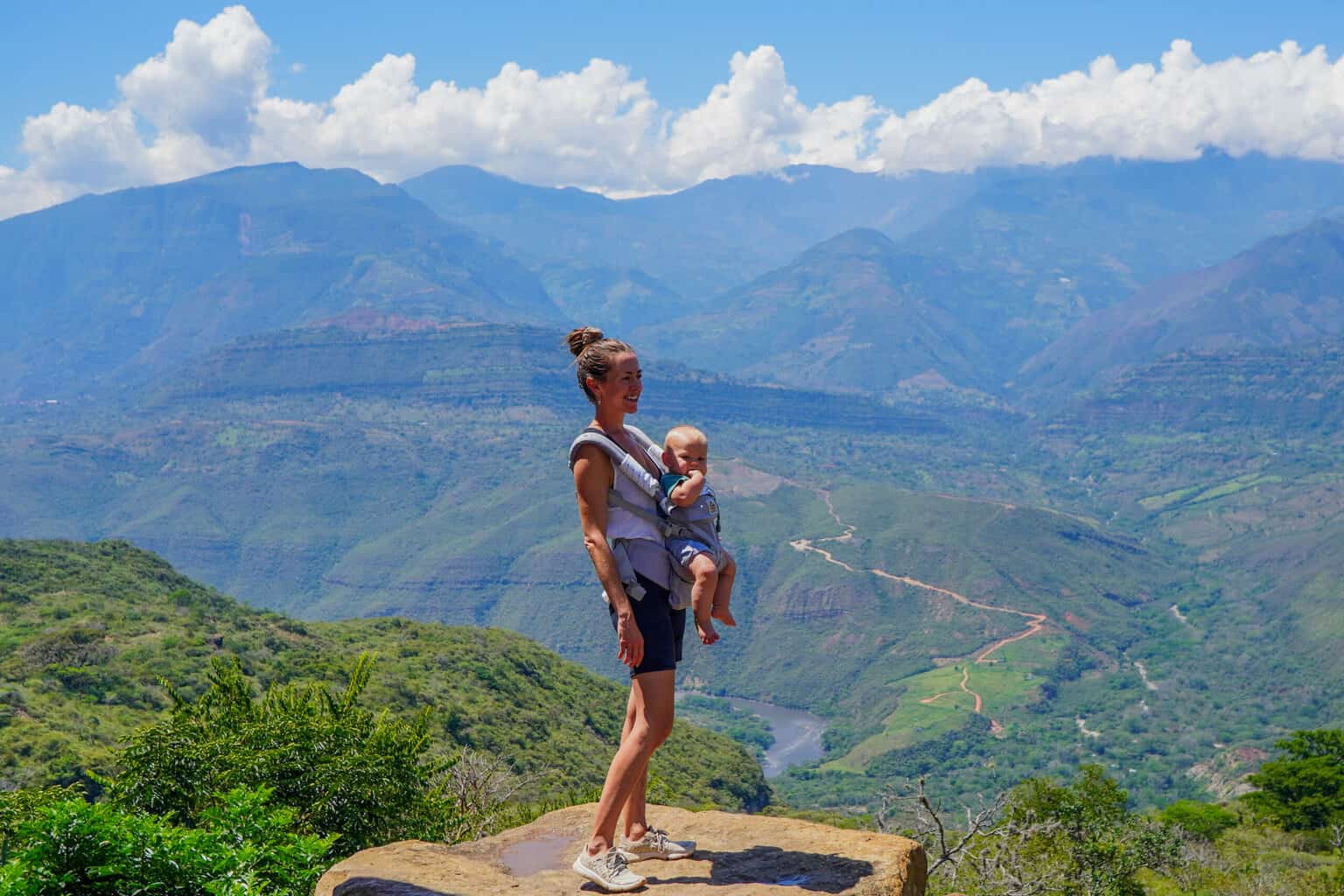Colombia 3 Week Itinerary: An Amazing Trip Guide
This Colombia 3 Week Itinerary is your ultimate travel guide for the best experiences in the country.
We spent six weeks traveling all over Colombia with our kids (including our baby) and we’ve narrowed down exactly what to do in Colombia in three weeks. I will give you first-hand recent insight into each destination in Colombia, including places to stay and our favorite unique experiences.
I’ll also address safety concerns and provide you with a travel guide to Colombia. I’ll even tell you what we would absolutely recommend and what we would suggest passing on so that you don’t waste your time.
⭐Tip: We also have dozens of travel videos on Colombia, which you can access by subscribing to our YouTube Channel.
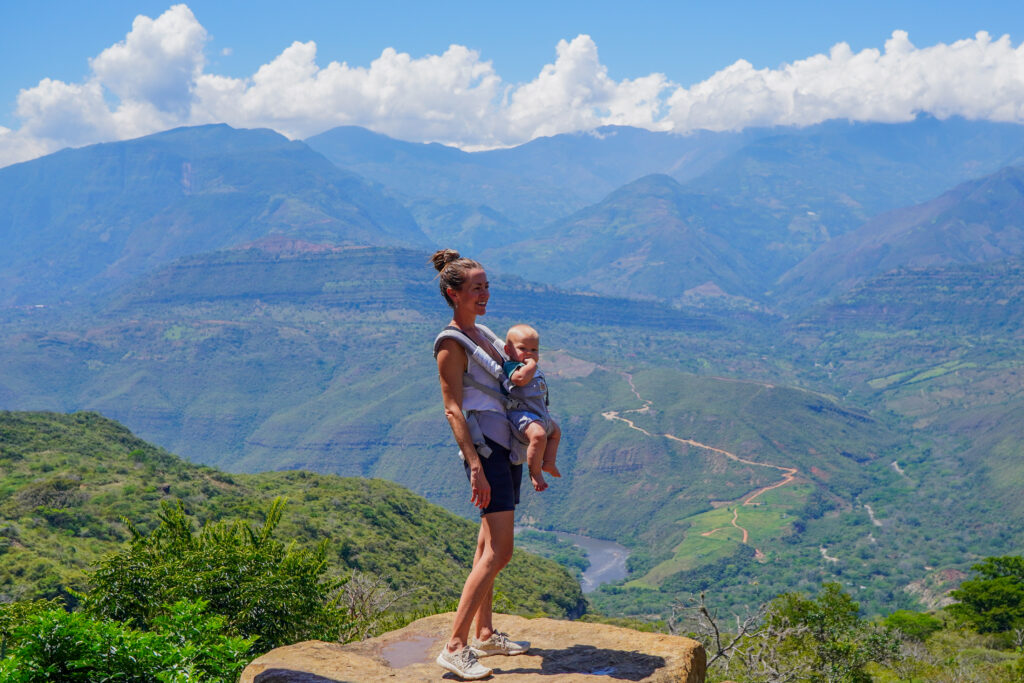
Colombia 3 Week Itinerary Overview
If you have 3 weeks to spend in Colombia, here is an overview of where I would suggest spending your time. You’ll also want to check out these extra tips and off the beaten path Colombia experiences!
Before we dive into the day-by-day of your multi-week itinerary, I want to address one of our biggest travel tips: building in leisure days.
When traveling with kids, I recommend taking a day of leisure for every 2-3 active days. This isn’t a science, but days at leisure are absolutely something to consider so that your trip is enjoyable and you aren’t trying to do it all.
Sometimes, our days at leisure are for catching up on work, engaging in other world school activities, sleeping, hanging by the pool, leisurely walking around town, or just playing games as a family. You will find that further down in this article, I give details and some additional activities to fill your time, should you want a more packed itinerary.
Daily Colombia Itinerary Overview
Day 1 – Arrive in Bogota
Day 2 – Bogota: La Candelaria and El Barrio Egipto Tour
Day 3 – Bogota: Paloquemao Market and Cooking Cooking Class Tour or Zipaquirá Salt Cathedral
Day 4 – Fly to Pereira
Day 5 – Coffee Region: Hike Cocora Valley, Tour a Coffee Plantation and Visit the Colonial Town of Salento
Day 6 – Coffee Region: At Leisure
Day 7 – Coffee Region: Jeep Tour & Cacao Farm ***This tour was a highlight of our trip!
Day 8 – Fly to Medellin
Day 9 – Day trip to Guatape (Climb Penol Rock)
Day 10 – Medellin: At Leisure or Guitar Tour or Comuna 13
Day 11 – Fly to Cartagena; Transfer via car to Las Islas Baru
Day 12 – Las Islas Baru: At Leisure (many onsite activities included)
Day 13 – Transfer to Cartagena, stay in the Walled City
Day 14 – Cartagena: Walk around the Walled City and Getsemaní neighborhood
Day 15 – Cartagena: At Leisure
Day 16 – Cartagena: El Totumo Mud Volcan and/or La Boquilla Fishing Village
Day 17 – Transfer to Tayrona Park area (long drive)
Day 18 – Day trip to Tayrona Park (Parque Nacional Natural Tayrona); Go hiking and swimming
Day 19 – Tayrona Park – Parque Nacional Natural Tayrona: At Leisure
Day 20 – Tayrona Park: Tubing down the Don Diego River
Day 21 – Fly out of Santa Marta back to Bogota to catch your international flight home
Read on to get into the details of each day.

Map of 3 Week Colombia Itinerary
Here’s a look at the main locations you’ll be staying in during your three weeks in Colombia, based on flying in and out of Bogota. Of course, you could also fly in and out of Medellin or Cartagena just as easily.
Bogotá ➡️ Pereira & Coffee Region (Salento, Valle de Cócora) ➡️ Medellín (Marinilla, Guatapé) ➡️ Cartagena (Isla Baru) ➡️ Tayrona Park ➡️ Santa Marta ➡️ Bogotá ➡️ Home
3 Weeks in Colombia Travel Itinerary in Detail
Here’s a detailed breakdown of how to spend each day in Colombia. We’ll recommend options for what to do, where to eat and where to stay, so that you have all the info you need to get the most out of your epic Colombia trip!
Day 1 – Arrive in Bogota
Bogota is the capital of Colombia and is home to Colombia’s largest international airport (airport code: BOG). Therefore, it’s a popular place to start your Colombia itinerary. Remember that Bogota has a high altitude at 2,600 meters, and therefore can be cooler and rainier than other parts of Colombia.
Tip: If you are prone to altitude sickness, you may want to plan a couple of days to take it easy and adjust to the altitude.
Day 2 – Bogota: La Candelaria and Egipto Tour
Day two, or your first full day in Colombia is a day spent exploring the vibrant neighborhoods in Bogota. Here’s our recommendation for both a popular neighborhood (La Candelaria) and a hidden gem neighborhood (Le Barrio Egipto).
What to Do in Bogota
Popular Neighborhood to See: La Candelaria
Off the Beaten Path: El Barrio Egipto Tour
Note: I would suggest a tour guide for both of these neighborhoods. (Definitely don’t go to El Barrio Egipto without a proper guide from the neighborhood.)
La Candelaria: Begin your day with a tour to wander around the streets of La Candelaria, one of the most historical places in Bogota. The area is adorned with both modern and colonial architecture, with a bit of a bohemian vibe.

Walk around Plaza de Bolivar, the current main square, as well as all the shops and vendors throughout the streets of La Candelaria. (Do watch out for pickpockets here.)
Tip: Check out our favorite healthy lunch spot in La Candelaria called Quina Y Amaranto.
El Barrio Egipto: From La Candelaria, you can walk to El Barrio Egipto. Remember, this entire area is an area that you definitely want to have a guide, primarily your for safety. (Essentially, your guide for La Candelaria can act as a translator, should you need one, for your local guide to El Barrio Egipto.)
You will likely meet your guide from El Barrio Egipto at La Iglesia de Nuestra Señora de Egipto, the entrance point into the Egipto neighborhood. From there, the guide will accompany you through this community, which they have worked really hard to turn from criminal street life to art and tourism.
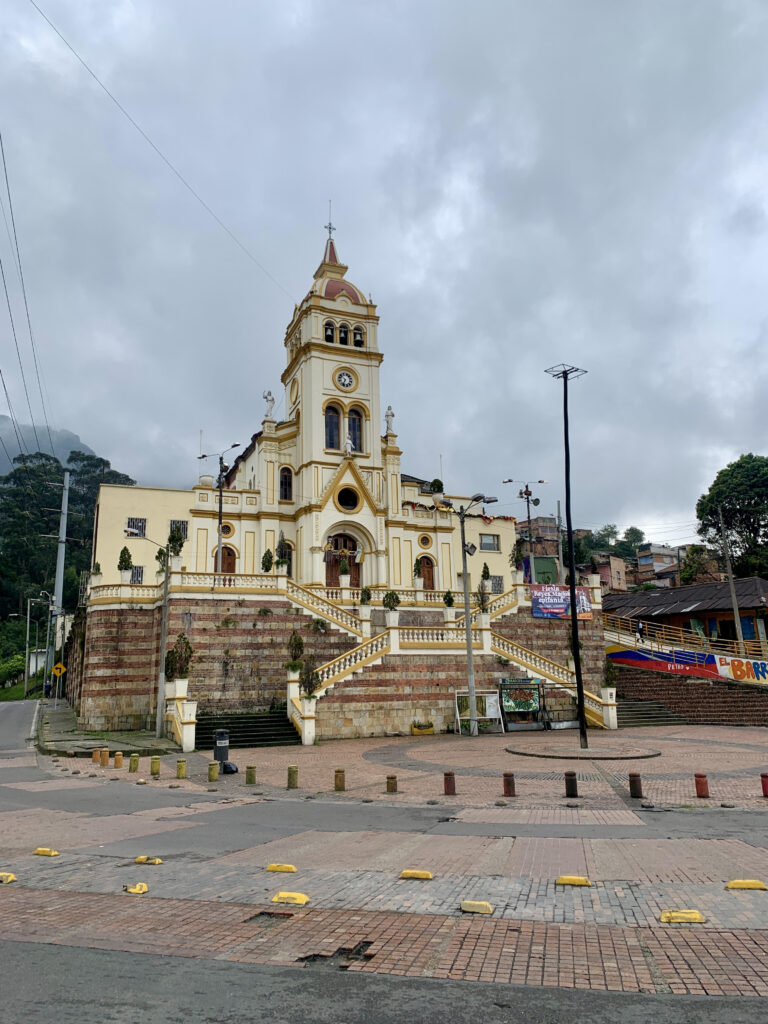
El Barrio Egipto was previously known as Colombia’s most violent neighborhood. It is definitely an off-the-beaten path Colombia tour, as it is a newer project and hasn’t experienced loads of tourism yet. (Our guide mentioned we were the first family he had!)
Touring El Barrio Egipto feels like what Comuna 13 in Medellin probably felt like before it became a tourist mecca. Therefore, we felt like this was one of the more special tours we took in Colombia.
The local Egipto guide can show you the invisible lines of the neighborhood, the street art and a look into the homes of the locals. There are still invisible lines, marking territories between rivaling families, but these lines aren’t enforced when community members are on tour. The rivals respect that tourism is helping their neighborhood.
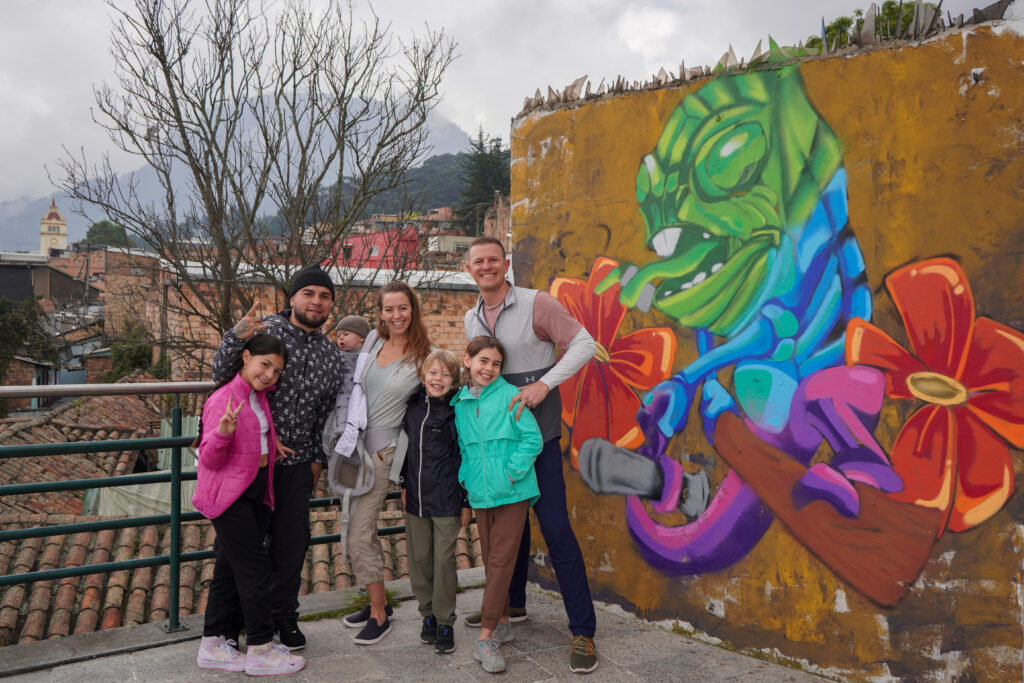
We visited our guide’s home, as well as the home of his mother to share a traditional snack of tea and cheese and hear more about their day-to-day life.
Safety: We hesitate to say anything is safe, as things can happen anywhere. However, we never once felt unsafe on this tour. As we mentioned above, make sure you take a local guide and do not venture into this neighborhood alone.
Where to Stay in Bogota
We stayed at both Hotel Viaggio Nueve Trez and Hotel NH Hacienda Royal during our two different stays in Bogota. We really liked Hotel NH Hacienda Royal and much preferred it for a number of reasons, including a nice room, location and delicious breakfast.
Hotel Viaggio Nueve Trez had a good location, too, and spacious two-bedroom apartment rooms, but it was dark and cold (no heat!), and the breakfast was mediocre at best.
Hotel NH Hacienda Royal had a large suite with a king bed separated by a TV/shelving stand, so a little less space and privacy. However, it was cozier and much nicer. The room had heat and a nice spacious bathroom area. Plus, it had a little area with a kitchen table and sink and windows overlooking the lush mountains.
The breakfast buffet spread was amazing with so many fruits, smoothies, eggs to order, salad, yogurt, pastries, and more. The hotel was located next to an organic grocery store & eatery, plus across from a playground, which made the location quite ideal for traveling with kids.
Healthy Restaurants in Bogota
Pura Vida in El Chico neighborhood of Bogota was a vegan and vegetarian restaurant that we frequented about once a day! They had the most delicious variety of healthy fresh food at amazing prices. From cold-pressed juices, smoothie bowls, a variety of entrees, avocado toast, and so much more. Plus, it had a great vibe to it!
Quina Y Amaranto in La Candelaria is a must. It’s a small restaurant with a cute, clean, colonial vibe and delicious vegetarian food. The menu is a set menu and all homemade fresh food!
Day 3 – Bogota: Paloquemao Market and Cooking Class or Salt Cathedral
Today, I’ll give you two options, so you can choose what might work best for you! We really enjoyed both of these experiences.
What to Do in Bogota
Option 1: Paloquemao Market and Cooking Cooking Class Tour
Paloquemao is Bogota’s largest and most popular market. Get a tour guide to take you through the market, identifying and tasting all the variety of fruit and vegetables that Colombia grows. (We do a lot of these types of tours all over the world and Colombia definitely has an amazing variety of yummy fresh fruit that you must try!)
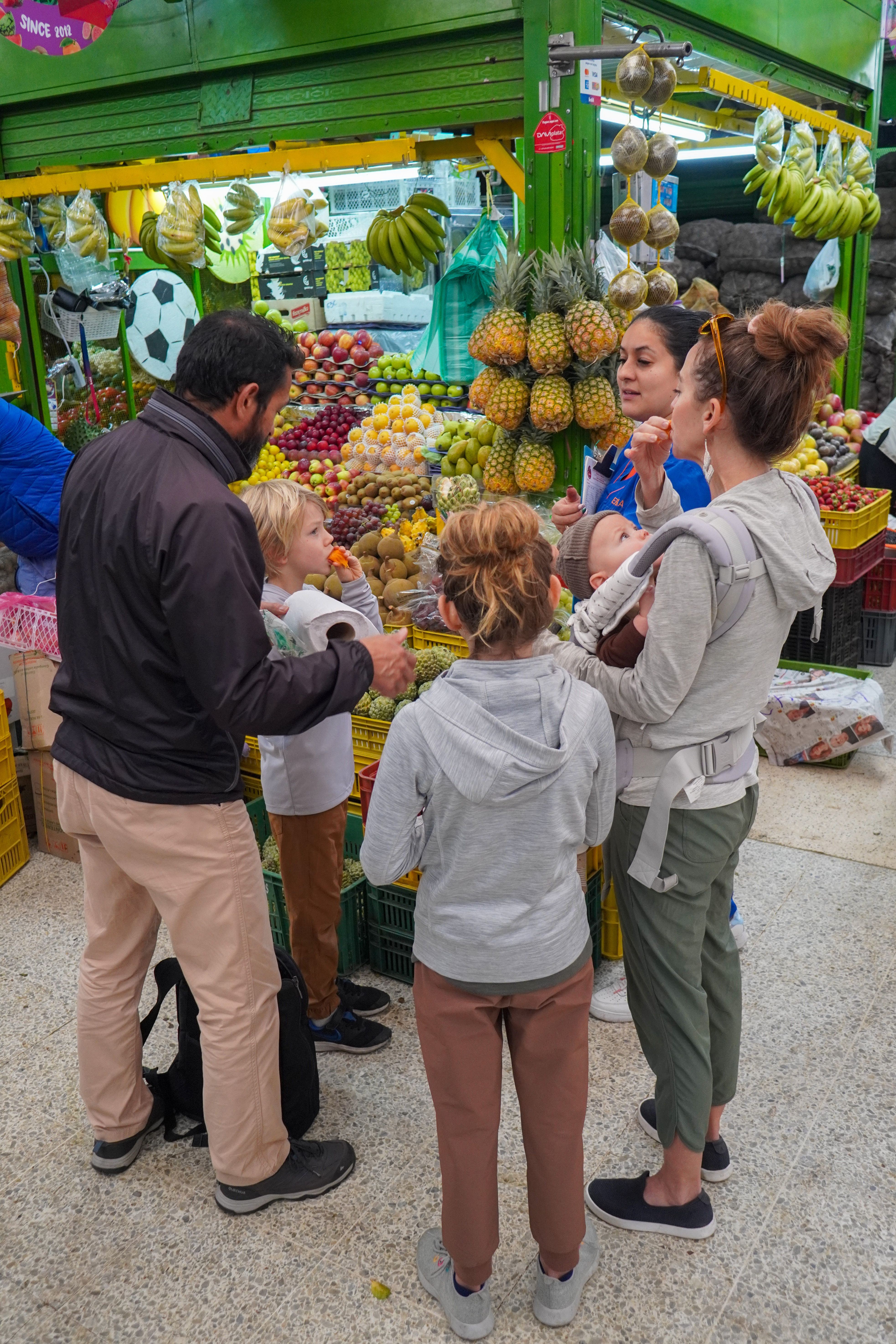
The cooking class instructor should give you and your guide a list of produce to buy from the market, which is a fun way to engage in the buying process. Our guide would tell the kids what to say and then they had to go purchase the produce, speaking Spanish!
From there, our driver took us to Con Contraseña for our cooking class. We were greeted by Catalina, owner and chef who was absolutely wonderful with kids. We helped prepare typical Colombian dishes (you can choose your menu ahead of time), as well as fresh Lulo (Naranjilla) juice. Afterward, we all enjoyed a meal together!
Book a top-rated tour of Paloquemao Market
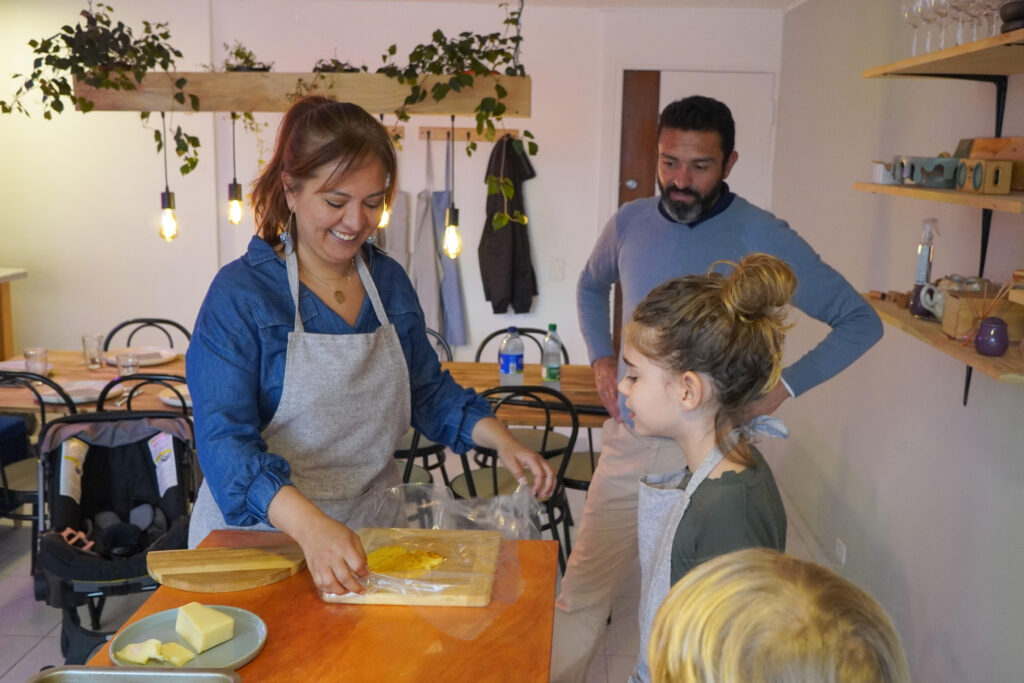
Option 2: Zipaquirá Salt Cathedral
Zipaquira Salt Cathedral is one of only three in the world! It’s located about an hour outside of Bogota, depending on traffic.
Important to note is that there is a train that runs from Bogota to Zipaquira, but it only runs on certain days each week, depending on the season. And, if you are unlucky (as we were), we had our tickets booked, but they canceled the train anyway.
The Salt Cathedral is situated 180 meters underground. It’s part of a larger active salt mine. Once you arrive at the Salt Cathedral, you will purchase your tickets and then proceed to the front entrance.
There, you will wait to be allowed in, as only a certain number of people can be inside at a time, and people enter in groups. You can start with the group, led by a guide, and then venture off by yourself as we did.
The Cathedral is three main sections, representing the birth, life and death of Jesus Christ. There are the Stations of the Cross, the actual Cathedral, lots of fun pathways to explore, and even an emerald museum.
There is also a movie theater, which we recommend. The brief movie takes you through the local culture and construction of the mine and Cathedral with English subtitles!
Book Zipaquira Salt Cathedral Tickets & Tours
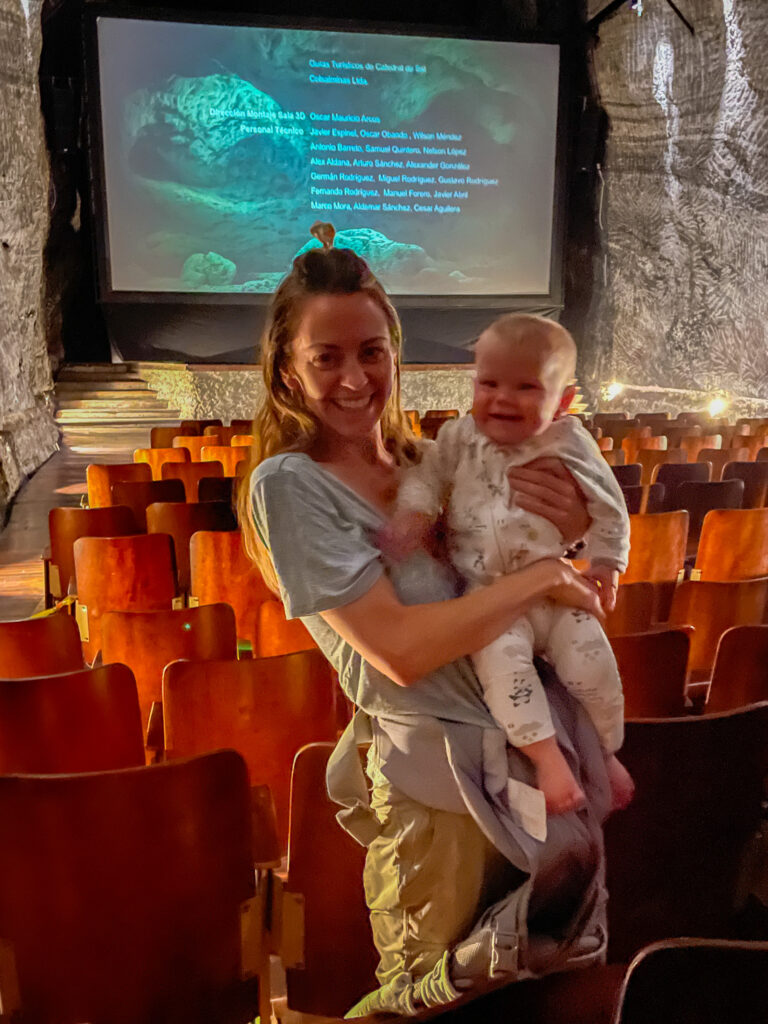
Day 4 – Fly to Pereira, Colombia’s Coffee Region
From Bogota, you will fly to Pereira, the Coffee Region. This is the quickest way to get from Bogota to Pereira. Several airlines such as Avianca and LATAM offer flights from Bogota to Pereira. The flight takes approximately 45 minutes, and there are several flights per day.
You can also take a bus or hire a car, but we recommend taking a flight, as domestic flights usually aren’t too expensive.
Where to Stay in the Coffee Region
While Pereira is the major city and main airport in the Coffee Region, the region itself is quite large. Therefore there is quite a selection of places and areas to consider during your stay.
We stayed at Hotel Las Camelias, a large family resort with multiple waterpark areas, including a lazy river, loads of kids activities, a small amusement park, mini golf and more. Definitely a fun resort if you are traveling with kids.
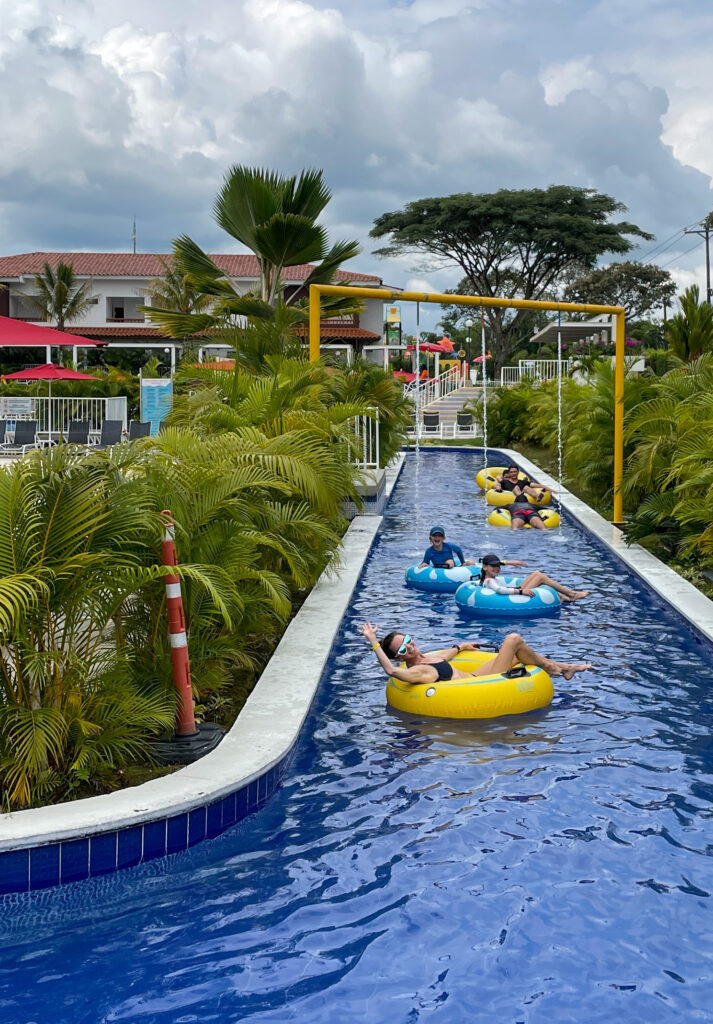
Hotel Las Camelias isn’t our typical boutique hotel stay, but we opted for this one for our kids, as there is a lot to do onsite. It’s busy with a lot of domestic tourists. We did half board with breakfast and dinner included, which was a good value. The food was okay and had a decent variety, but nothing great in our opinion.
I would also consider staying in or near Salento, which is the picturesque colonial town from the movie, Encanto. It seems to be more central to the activities we were doing in the area, such as hiking Cocora Valley.
Where to Eat in the Coffee Region
There are numerous towns and restaurant options throughout the region, but if you find yourself in Filandia (a very cute colorful colonial town), you must eat at Aro Iris.
It’s a vegetarian and vegan restaurant in the heart of Filandia with absolutely delicious, thoughtful ingredients and a really interesting antique atmosphere. Even the meat eaters with us loved it. There was a set menu and were some of our favorite dishes during our entire trip to Colombia!
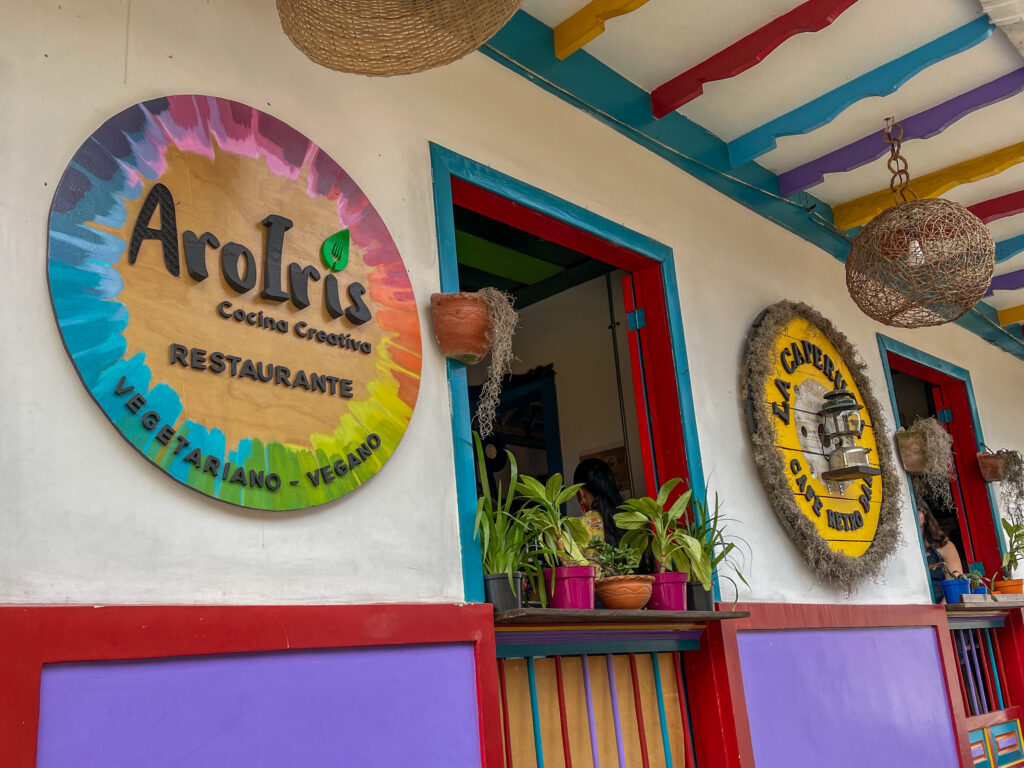
Day 5 – Coffee Region: Hike Cocora Valley, Tour a Coffee Plantation and Visit the Colonial Town of Salento
I really don’t think you need a tour guide for this day, but you would want a driver or to take a tour to get from your hotel to each activity. If you do Cocora Valley, tour the Coffee Plantation and visit Salento, it’s a full day’s worth of activities.
What to Do in the Coffee Region
Hiking Cocora Valley
The best time of day to visit Cocora Valley is the morning (which has been true for our favorite hikes around the world). Of course, this may depend on the weather forecast for the day.
Starting your day hiking Cocora Valley will no doubt be spectacular, as you enjoy walking amidst the beautiful wax palm trees (cera) and diverse fauna of the region.
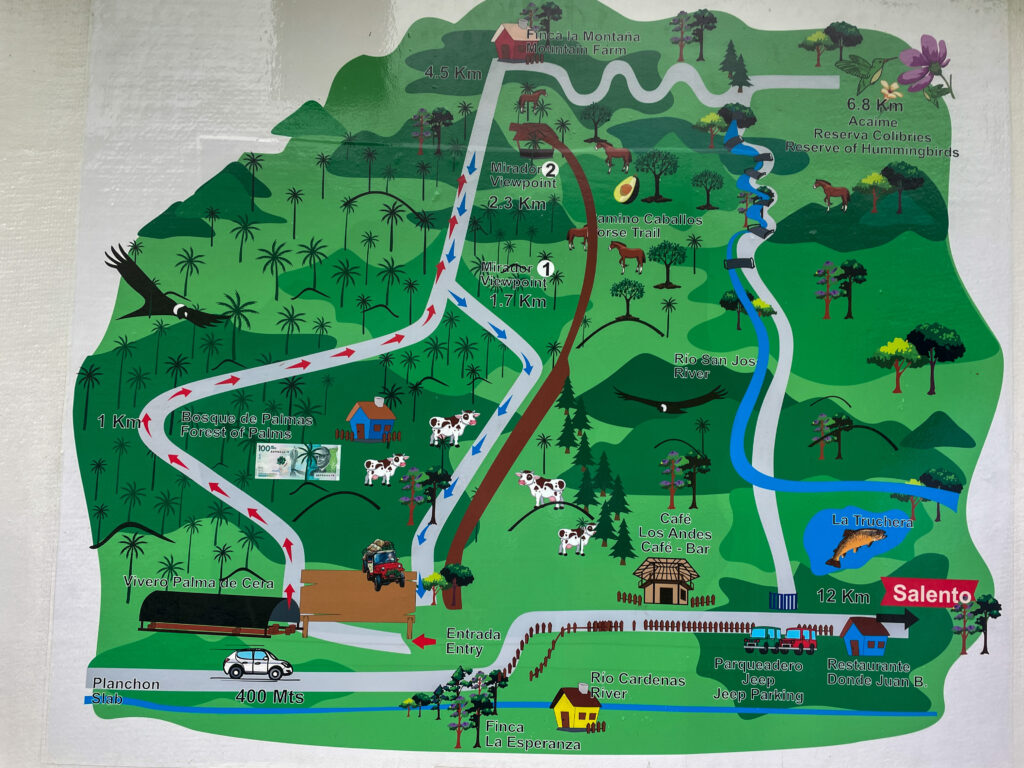
We decided to hike for about 2 hours at a leisurely pace. Of course, you can decide to hike for 20 minutes or 5 hours, depending on what type of activity you want for the day! The further you hike up, the less crowded it will be.
Most people tend to stay towards the bottom, get some photos and leave. The benefit of having a guide is to hear the stories about the native tribes that inhabited the area and point out various flora, fauna and birds of the region.
Tip regarding Cocora Valley weather: We experienced all seasons in Cocora Valley. It was sunny and hot, then chilly and foggy, and finally downpouring rain. Come prepared!
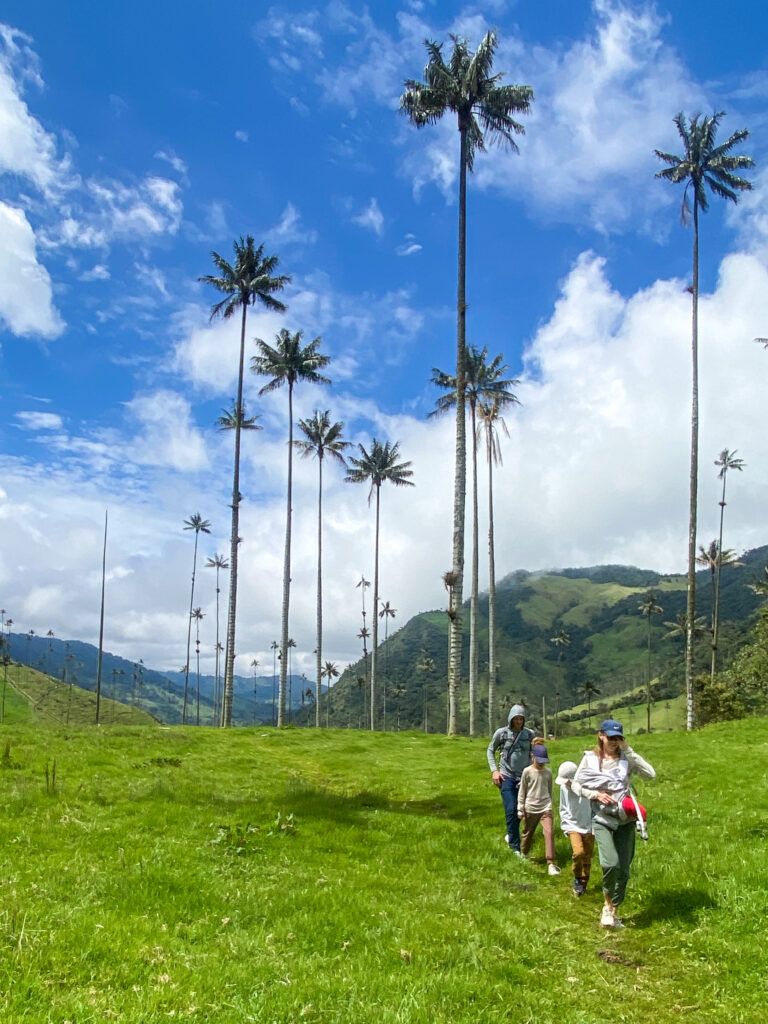
Visit Salento:
Salento is a picturesque town adorned by colorful houses and colonial architecture. The streets are lively with vendors and shops and the smell of freshly roasted coffee.
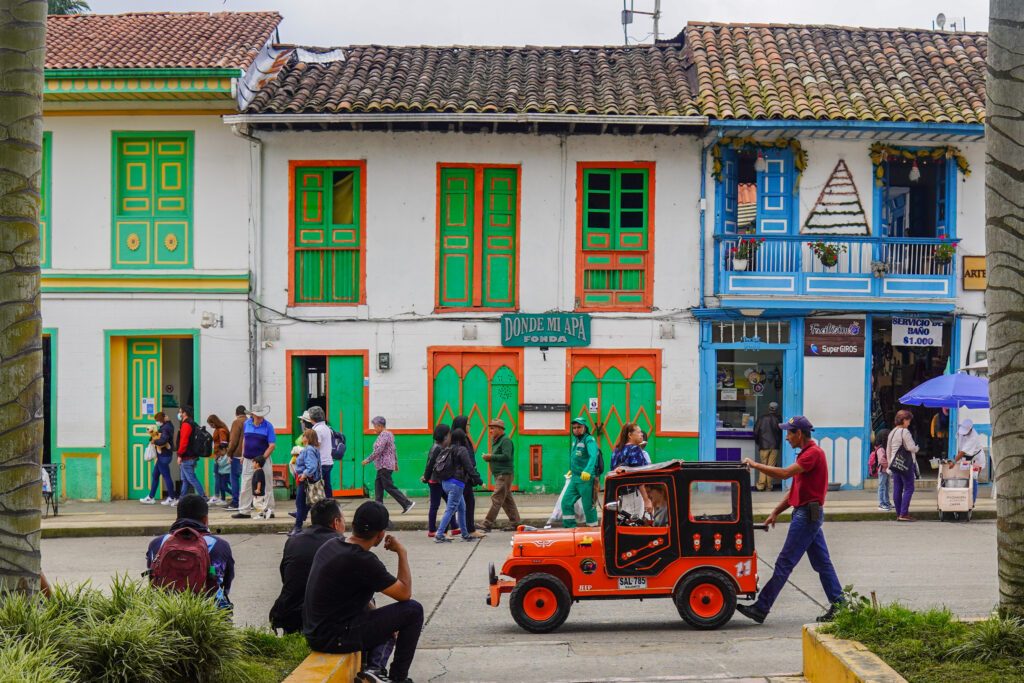
When you are in Salento, you’ll have many options for food and snacks. Try this local chontaduro and borojo snack from a local vendor.
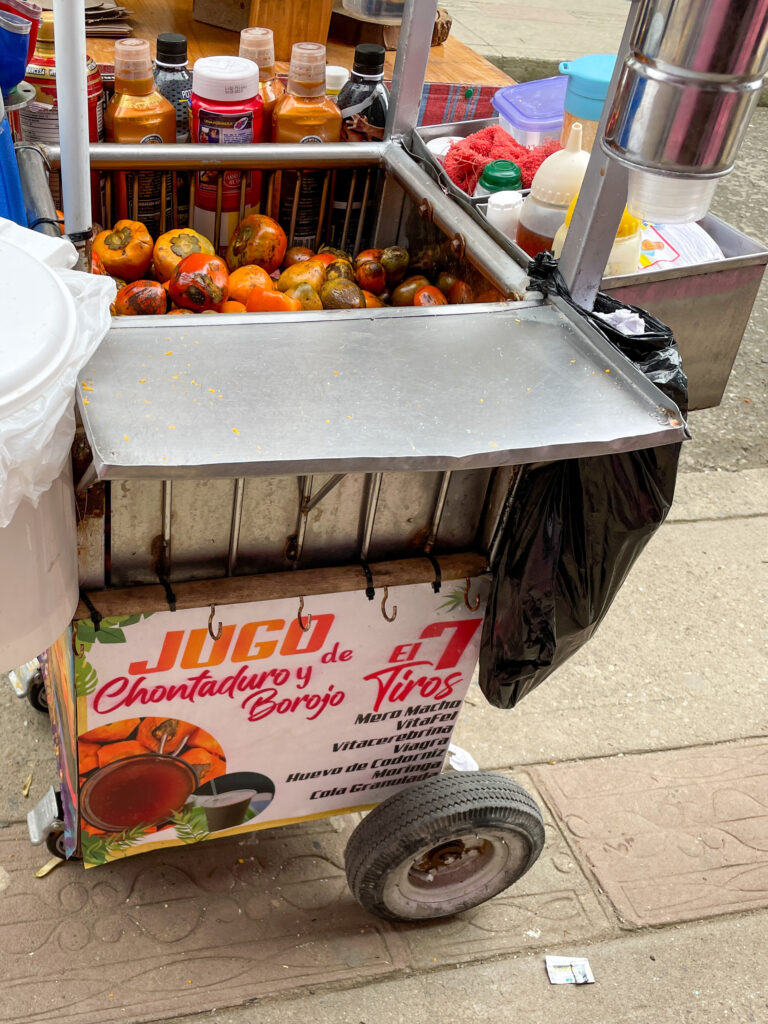

Tour a Coffee Plantation:
There are many coffee plantations in the region. I would suggest finding one that is smaller and uses organic practices. You can learn all the details of the coffee process, from planting to picking and roasting.
Of course, a coffee tour isn’t complete without a tasting, so make sure your tour includes a coffee tasting!
We toured Las Acacias Coffee Farm. While it was a beautiful farm and we were able to learn the entire process from planting to harvest and roasting, the tour itself lacked a bit of passion and left a little to be desired (in my honest opinion).
Book a Highly Rated Salento Coffee Tour
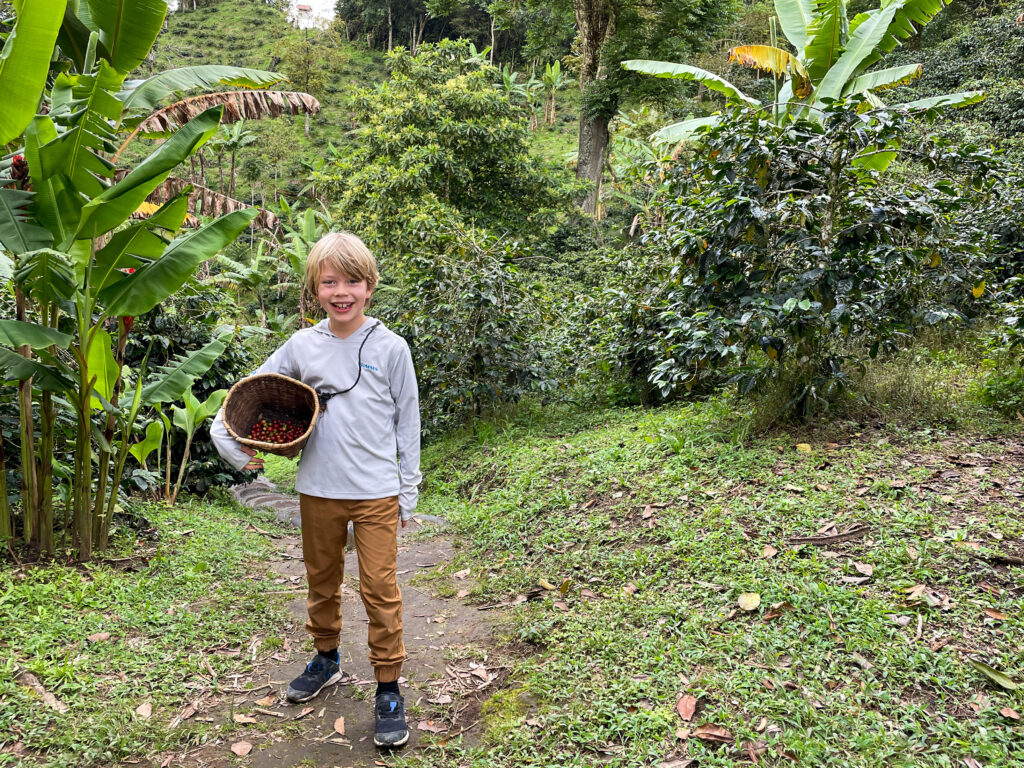
Did You Know: Colombia exports the majority of the coffee it produces. It doesn’t leave enough to fulfill the demands of its population and then imports less quality coffee. So, best not to assume that just because you are having a cup of joe in Colombia that you are actually drinking coffee from Colombia.
Day 6 – Coffee Region: At Leisure
Most of the hotels in the Coffee Region have onsite activities which you can choose from or just enjoy a day by the pool! If you choose to leave out an activity from Day 5 on your Colombia itinerary, you can move it to today.
Day 7 – Coffee Region: Jeep Tour & Organic Cacao Farm ***This tour was a highlight of our trip!
This was a highlight of our trip to Colombia. It is one of those experiences that you won’t forget. Most people take a coffee tour in the Coffee Region of Colombia (and we did that, too), but this Cacao Tour was way better and more memorable.
Our hotel was located quite far from the main starting point of this tour, which is the town of Marsella. (Something to note when booking hotels is the Coffee Region is large and it takes time to drive to all the various towns and areas.)
We arrived in the town plaza of Marsella and hopped right into our Jeep, called a Yipao (or Jeepao), which means a “fully-loaded Jeep Willy.” These traditional vehicles in the coffee region are often used to transport coffee beans, vegetables and a variety of other stuff.
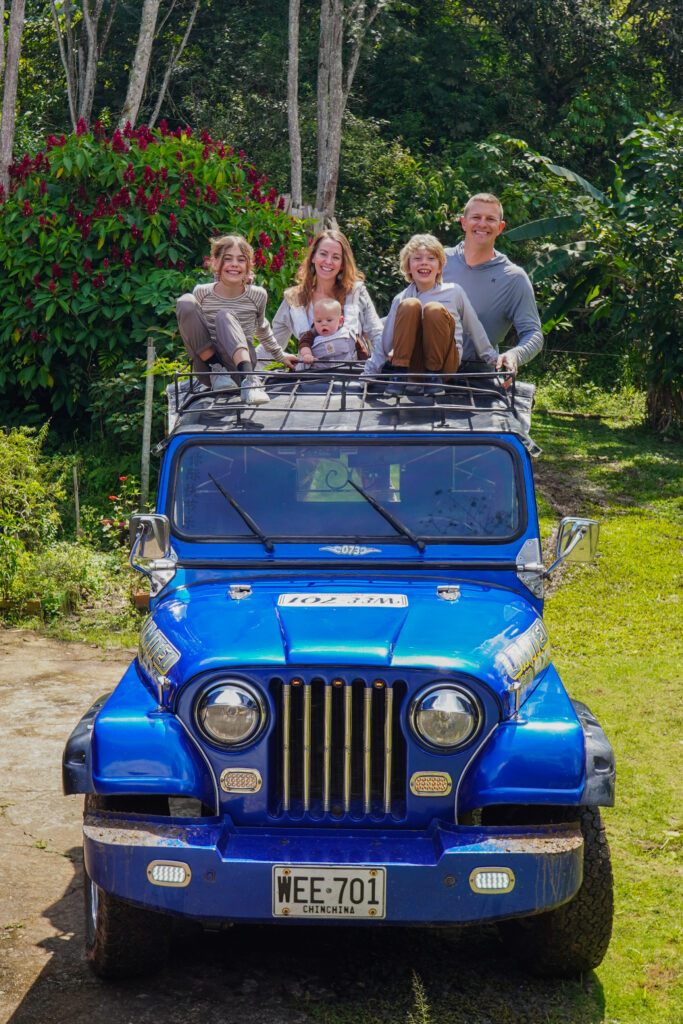
From the town, you will venture out in the open-aired jeep to the beautiful landscapes of the coffee region, passing lush greenery, small towns and off-roading through jungle. It can be a bumpy ride at times but so much fun with gorgeous views and fresh air blowing your hair.
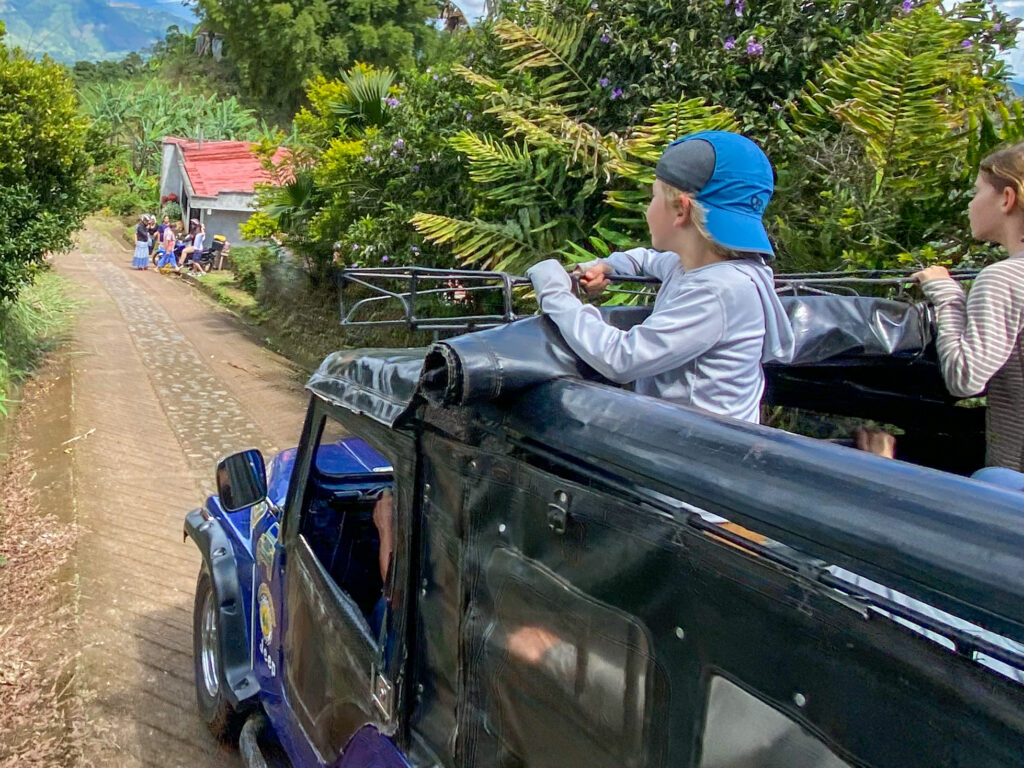
Then you arrive at one of our favorite organic farms that we’ve ever visited, largely in part because of the warm welcome and passion from the owners. Luis Fernando and his wife are owners of Brisas del Cauca. They are knowledgeable, fun, passionate and warm. They absolutely make the experience!
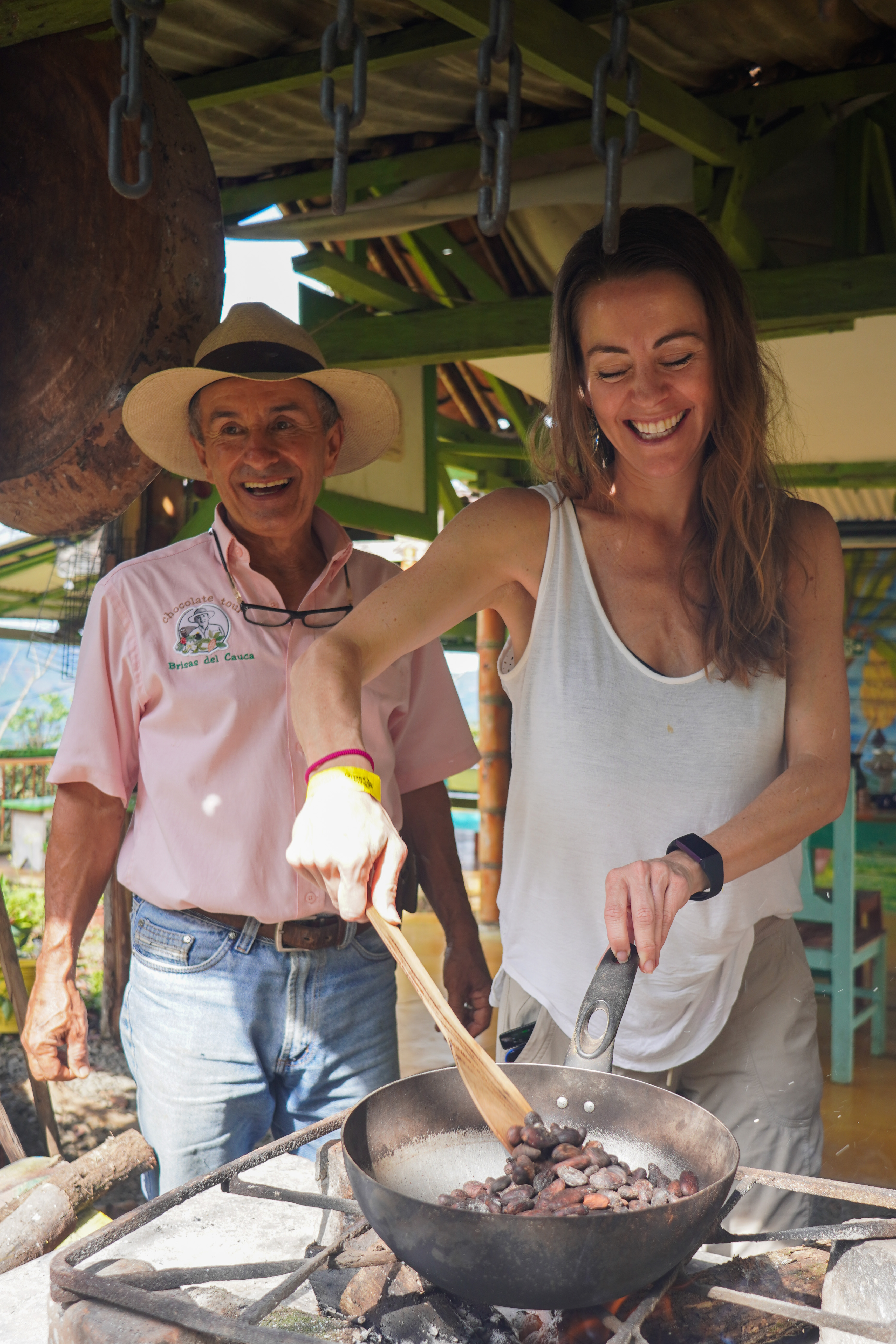
We enjoyed a delicious lunch (with a dessert I still crave) made with local organic ingredients from their farm. Then we walked around the grounds of the organic farm, tasting all the delicious fruits and herbs along the way.
Finally, we all got to partake in making chocolate – from the seeds, to roasting, grinding and preparing chocolates, as well as a yummy cacao drink. It was such a fun, memorable experience all around.

After spending the day at Brisas del Cauca, the jeep will take you back to Marsella, where your driver can meet you to return you to your hotel.
Absolutely plan this tour into your Colombia trip itinerary!
Day 8: Fly to Medellin
While you can take a bus from Pereira to Medellin, I would recommend flying, as domestic flights are usually not too expensive.
Where to Stay in Medellin
In Medellin, we stayed in Hotel Estelar Apartments. We had a 2-bedroom, 2-bathroom suite overlooking the city. For our family of five, this worked out perfectly.
The hotel provides breakfast (nothing great, but okay to get your morning started). It is conveniently located next to a grocery store, across from a mall and a short walk to another complex of restaurants and shops. We found the location to be excellent and our hotel room to be spacious!
Day 9 – Day trip to Guatape (Climb Peñol Rock)
The town of Guatape is about a 2-3 hour drive from Medellin. It is famous for the reservoir and huge stone rock called El Peñol.
What to Do in Guatape
I suggest visiting El Peñol first thing in the morning before it gets really crowded. You will climb 600 steps to the top of the rock, where you will be rewarded with stunning views of the region. There is one path of stairs for the climb up and another path of stairs for the climb down.
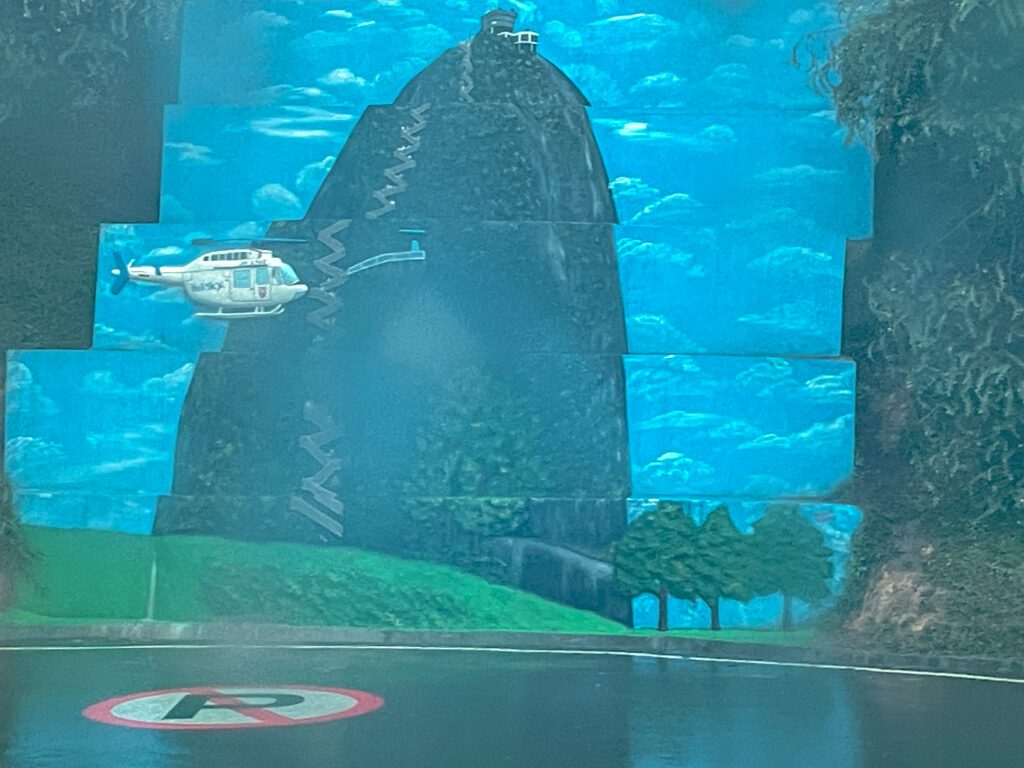
(You could consider taking a cool helicopter ride in Guatape to see El Penol from the skies as well.)
After, I would suggest heading to the town of Guatape. Our kiddos love boat rides, so we opted for a 45-minute boat ride around the reservoir. Note, there is no swimming in this reservoir.
From the boat docks, you can walk over through the streets of Guatape’s colorful houses. Be sure to take notice of the traditional painted carvings on the lower parts of the houses. These panels are called zocalos and create a bright cheerful town.
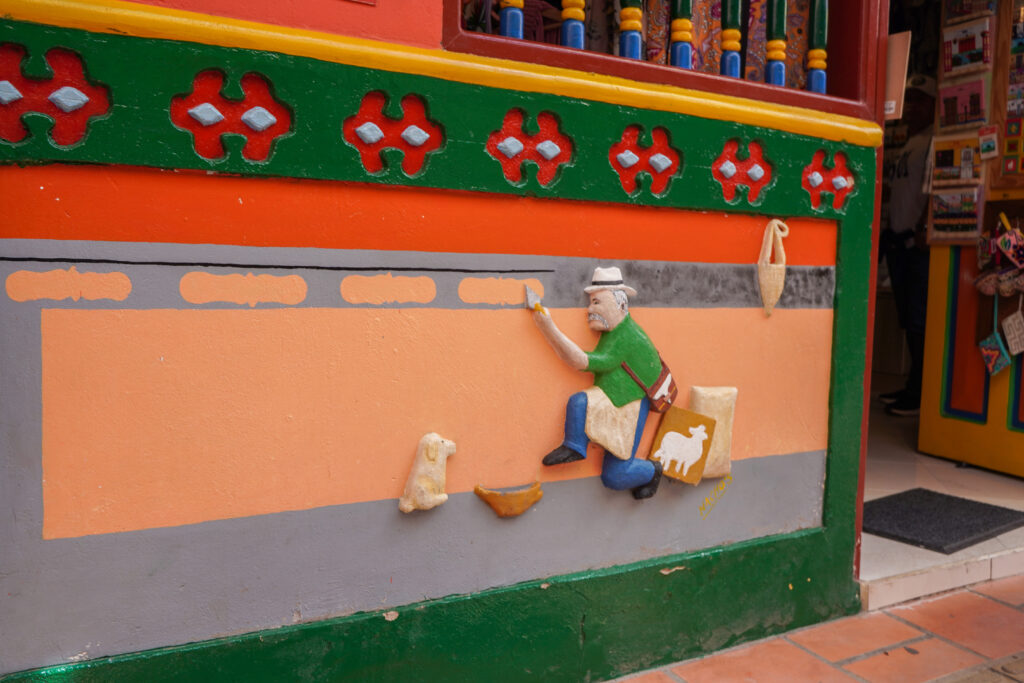
There is actually quite a selection of healthy restaurants in Guatape, including many vegan and vegetarian restaurants. We had a delicious lunch at Restaurante Vegano Zona Prosalud right in the center of town.
From there we walked to Calle del Recuerdo, the street with the iconic colorful umbrellas. Meandering down the street, you’ll find a little chocolate shop called La Tiendita de Chocolate. If you love chocolate, I recommend treating yourself to delicious (and very inexpensive) chocolates!
Book a Tour of Guatape, El Peñol Rock & Boat Tour
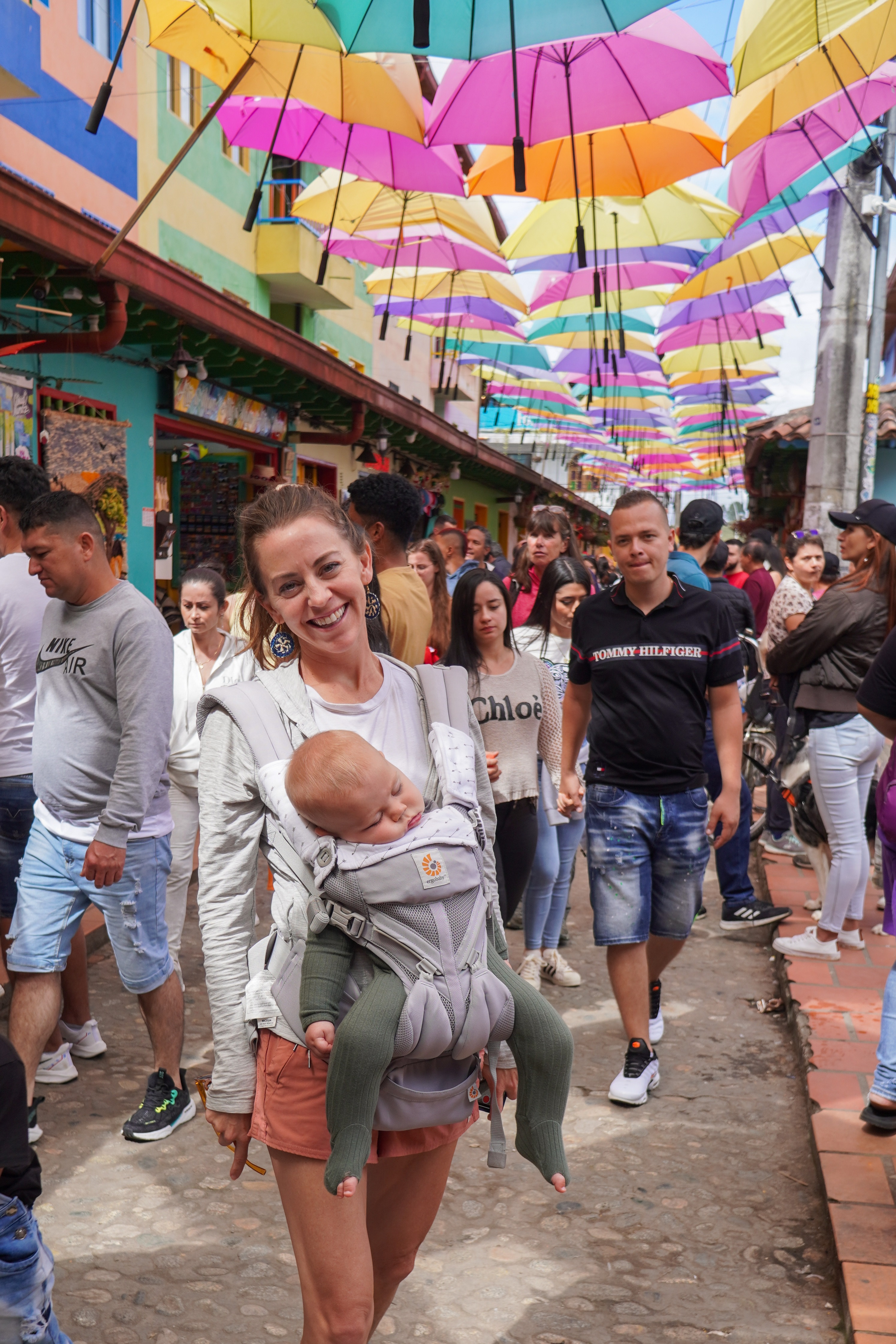
Day 10 – At Leisure or Guitar Tour or Comuna 13
Depending on how much you want to pack into your Colombia trip versus wanting to relax, today contains some optional tours you can consider in Medellin.
What to Do in Medellin
Should you decide a day of leisure is not needed, consider these excursions in Medellin:
✔️Guitar Tour: Medellin is known for guitar making. Honestly, this would be the coolest souvenir from Colombia to bring back home, but a bit impractical to try to carry throughout the rest of your trip.
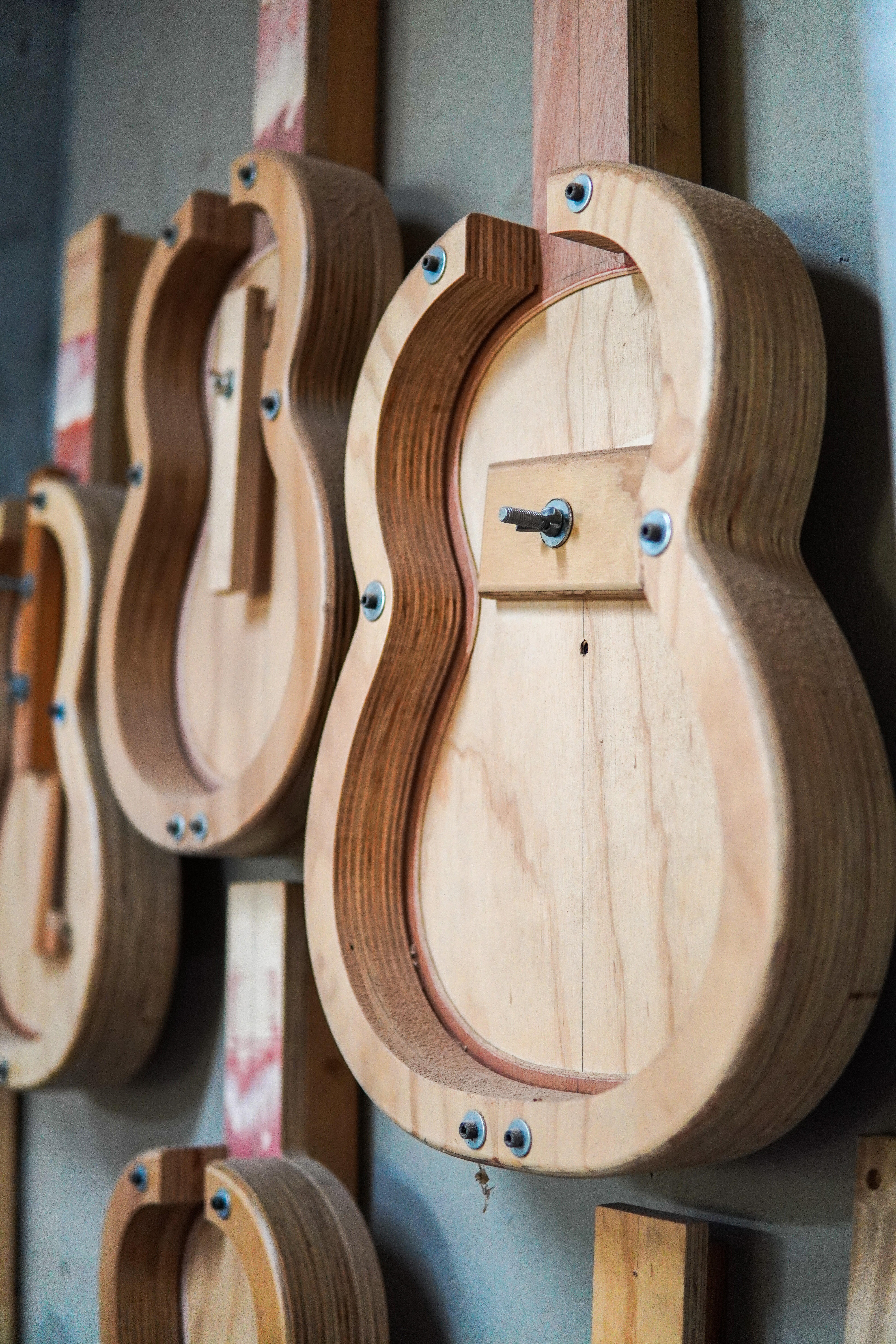
✔️Comuna 13: Infamous for being one of Medellin’s most dangerous neighborhoods (in the past). However, the area is safe to explore now and you will find it full of tourists. The community is committed to improving the neighborhood and has now turned to tourism, selling their goods along the streets.
You will find the history of struggle and hope for a brighter future depicted on the walls of Comuna 13 in bright graffiti.
Book a Top-Rated Comuna 13 Graffiti Tour & Street Food
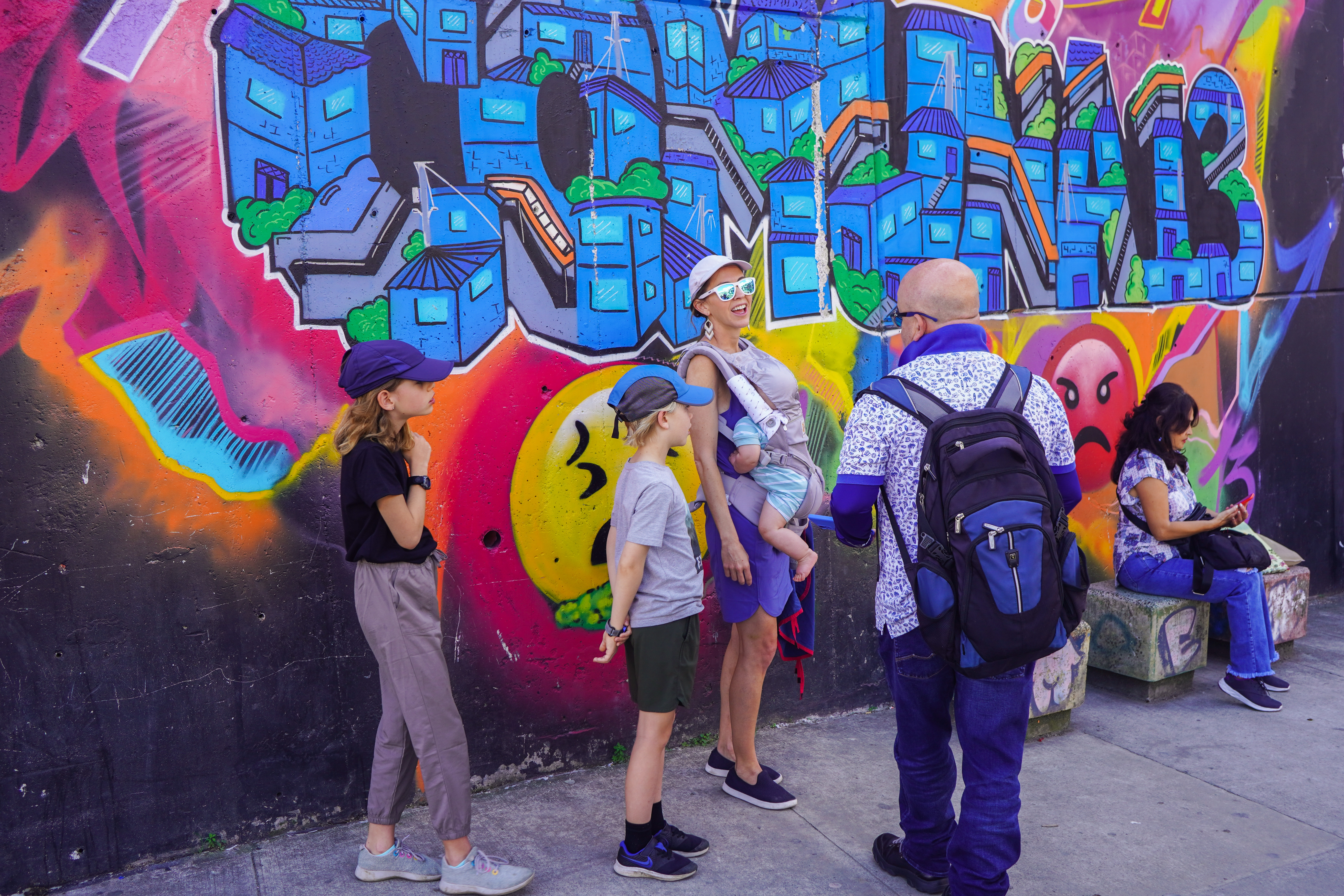
✔️Botanical Gardens: For a leisurely outdoor day.
✔️Cable Car Ride: With views of the city of Medellin.

Day 11 – Fly to Cartagena; Transfer via car to Las Islas Baru
Take a domestic flight from Medellin to Cartagena. Cartagena Airport is surprisingly quite small and set in a neighborhood. From the airport, set up a driver to take you to Islas de Baru for a relaxing beach stay.
How to Get From Cartagena to Islas de Baru
From Cartagena to Islas de Baru takes approximately 1.5-2 hours. Google Maps shows that it is much shorter, but from our experience, it took quite a bit more time because the road out to Islas de Baru is a dirt road with potholes. It will also depend a bit on the time of day you go through traffic in Cartagena.
Where to Stay in Islas de Baru
We would highly recommend staying at Hotel Islas Baru. This is a great upscale eco-stay in Colombia, with so many amenities included. We stayed in a two-story bungalow with a private pool overlooking the sea.
Note that the bungalow stories are connected from the outside and not inside. Each story had its own large bathroom. The rooms had mini refrigerator and fresh fruit and water was provided. You hop on golf carts to get around the complex, or, our favorite was to use the bicycles, which were provided (they even had kids bikes). We also walked everywhere easily on the beautiful wooden paths.
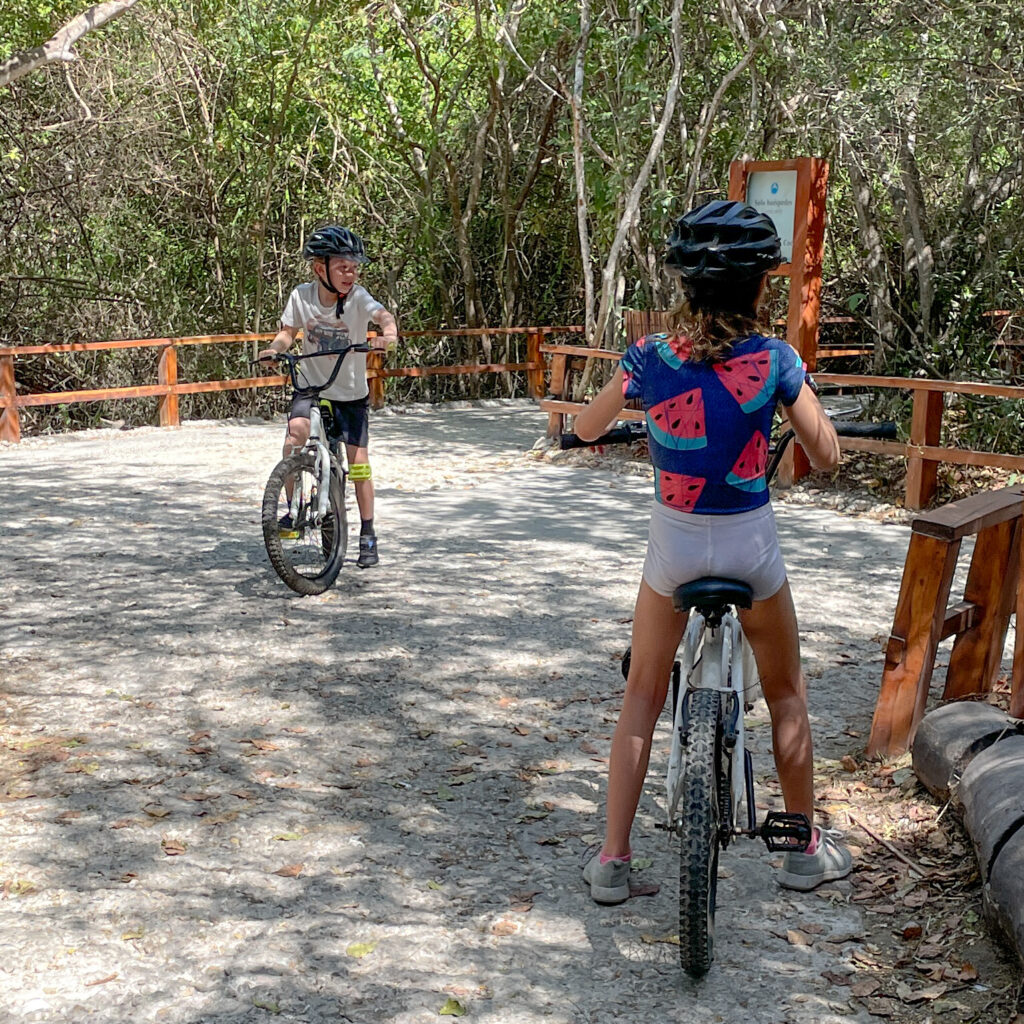
Breakfast was a highlight, complete with just about every type of food you could want. Smoothies, fresh fruit, eggs to order, yogurt bar, breads, pastries, cheeses, fresh juice, meats, pancakes and more. And the setting is gorgeous, right on the water – a perfect way to start your day.
The front desk staff was wonderful. From there it was hit or miss. Some of the staff was lovely and others were mediocre. It is a larger eco-resort, so we know it would be hard to have perfect staff.
The resort also has a beach set in a cove, meaning there are calmer, clear waters. Included are kayaks and paddleboards, as well as beach loungers. There are a few restaurants onsite as well.
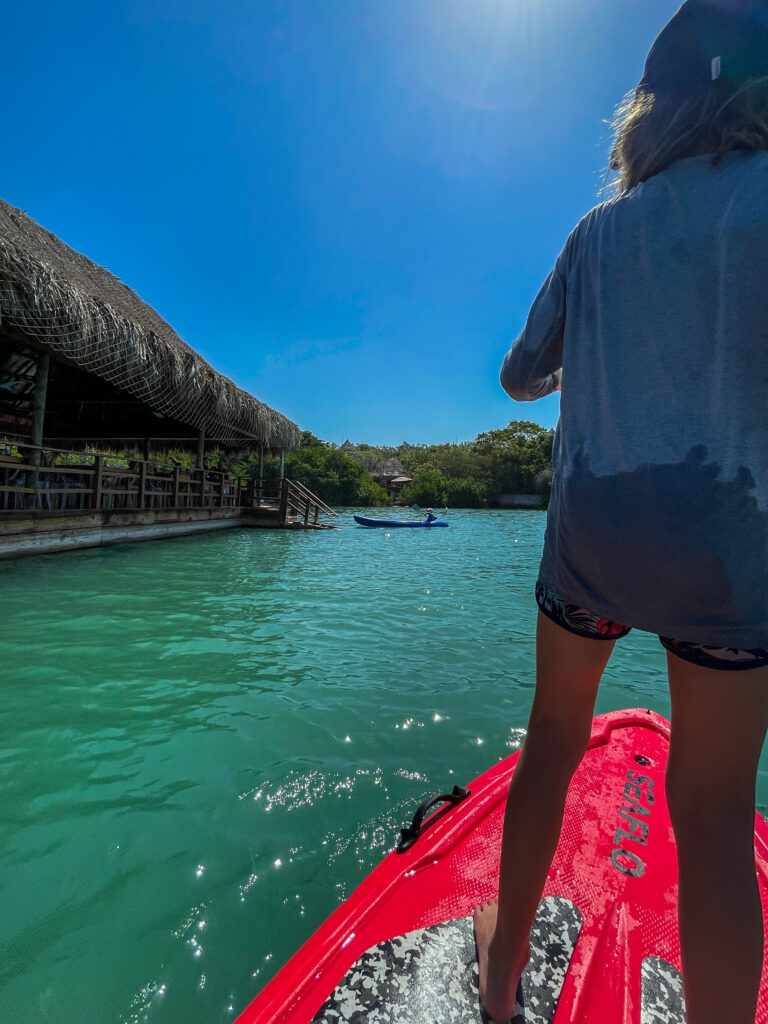
Hotel Islas Baru also has a private island and free boat transfer. You can take the 15-minute boat ride to the private island and enjoy the pool and beach there. They had a restaurant and bathroom amenities on the island, as well as some bungalows.
There is also a yoga studio and spa. Overall a fantastic place to stay to enjoy nature, the beach, good food, and relaxation. It’s worth the effort to get to Islas de Baru!
Day 12 – Las Islas: At Leisure
Enjoy Hotel Las Islas Baru Resort and all the amenities it offers. Our perfect day was a relaxing morning breakfast, followed by a paddleboard and swim. We biked back to our bungalow for a rest and dip in our private pool, before taking the resort boat transfer to their island, where we spent the late afternoon.
Day 13 – Transfer to Cartagena, stay in the Walled City
You probably won’t be quite ready to leave Las Islas (we recommend three nights in Las Islas if you have the time to spare), but if you are traveling Colombia in three weeks it’s time to move on!
You’ll have a driver pick you up to transfer you to Cartagena. Again, depending on traffic and the condition of the dirt roads in Las Islas, the drive can take 1-2 hours.
Where to Stay in Cartagena
Definitely stay within the Walled City, also known as El Centro. It is full of shops and restaurants, has a colonial vibe and is safer for tourists. It is surrounded by a wall, which is full of more shops and restaurants.
We recommend walking along the wall in the evening when the sun starts to go down and isn’t so intense! The vibe is fun!
While we stayed at Hotel Santa Catalina, we found the room to be a bit small. However, the location was wonderful and breakfast was yummy.
I would also suggest checking out Hotel Bantu. This is the hotel we were planning to stay in but had to change around our dates and then it wasn’t available.
If you have more of a budget, absolutely check out some of the more iconic and luxurious hotels in Cartagena.
Day 14 – Cartagena: Walk around the Walled City and Getsemaní neighborhood
Cartagena is hot year-round. Take the temperature into consideration when deciding when and what to do in Cartagena.
What to Do in Cartagena
Stroll through the Walled City:
Cartagena’s Walled City is great for strolling the colonial streets, popping into shops, grabbing a bite to eat or cooling down with an ice cream treat.
Visit Castle San Felipe:
Our kids really enjoyed a tour of this impressive fortress that overlooks Cartagena. They loved learning why it was built on top of San Lazaro hill to defend the city from pirate attacks. It is considered the greatest and strongest fortress ever built by the Spaniards in any of their colonies.
Walk to Getsemani neighborhood:
This has become a popular neighborhood after making a Forbes List of Coolest Neighborhoods. The streets are colorful with art. During the evenings, the neighborhood comes alive in the streets with music and vendors.
Book a Walled City & Getsemani Tour
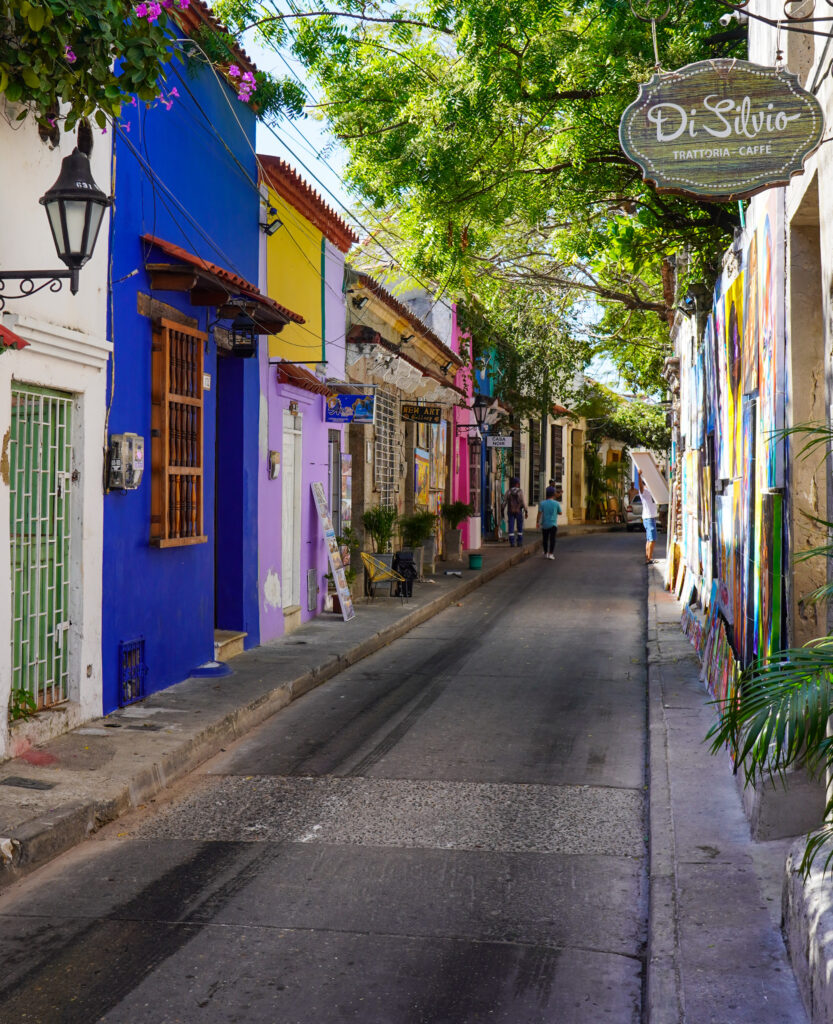
Restaurants:
We stopped for dinner at El Bololo, which had delicious vegetarian bowls and smoothies and a cute cafe vibe right off the plaza in Getsemani. I’d also recommend Celele, which was recommended to us as an amazing, upscale restaurant that uses locally sourced ingredients and is particular about where each ingredient is sourced!
Day 15 – Cartagena: At Leisure
Enjoy a day meandering around Cartagena at your leisure or consider moving one of the activities from Day 14 or 16 to today.
View Highly Rated Cartagena Tours
Day 16 – Cartagena: El Totumo Mud Volcan and/or La Boquilla Fishing Village
These activities can be done on the same day as they are both in the same direction outside of central Cartagena. However, they can also be split into separate days. During our trip to Colombia, we opted to do La Boquilla one day and then on another more leisurely day, go to El Totumo in the late afternoon (as the sun wasn’t so hot) and it was a wonderful relaxing activity!
What to Do in Cartagena
La Boquilla Fishing Village:
La Boquilla is a small fishing village north of Cartagena. Here you can take a trip in a wooden canoe through the mangroves of La Ceinga de Tesca. A local guide from the village will accompany you, describing the ecosystem.
You will learn to fish, the traditional way, by casting nets into the water. After, you can have a traditional seafood lunch at one of the restaurants on the beach.
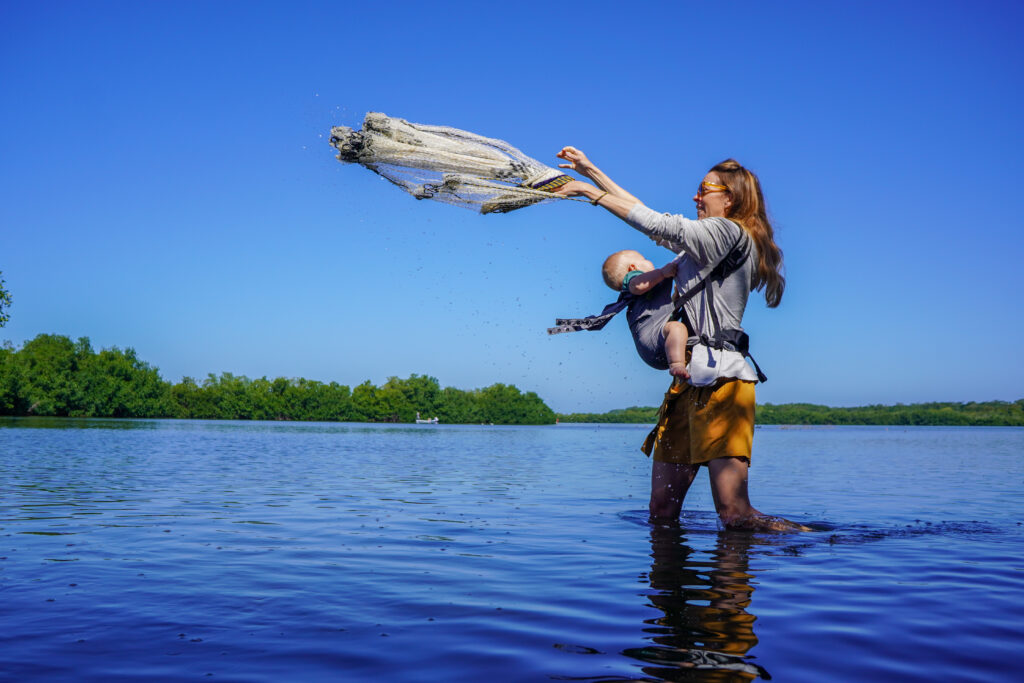
El Totumo Mud Volcano:
El Totumo is about 45 minutes from Cartagena. It is essentially a mound of mud at about 50ft high. You can access the crater via a wooden staircase. To get inside the crater, you go down a couple of makeshift stairs and descend into the mud.
Only around ten people can be inside the mud crater at a time, so if it is busy, you may have to wait. We were fortunate to have the place to ourselves most of the time.
Note: When you arrive, there will be a flock of locals that immediately approach you and want to help you up the stairs, take your shoes, etc. In the mud crater, they will try to give you a massage and afterwards help you to the lake to clean off. They are persistent, but you do not need to accept any of these things, as they do expect a tip.
I accepted the massage and for our shoes and stuff to be carried down to the lake afterward our mud time. At the lake, a local lady bathed all of us to scrub the mud off. I thought it was all part of the fun experience and worth the tip.
And the lake bathing is quite picturesque! I think we tipped about USD$15 total for everything, but it is a bit of a free for all as to what you choose to tip.
Book a Full Day Tour to El Totumo Mud Volcano from Cartagena
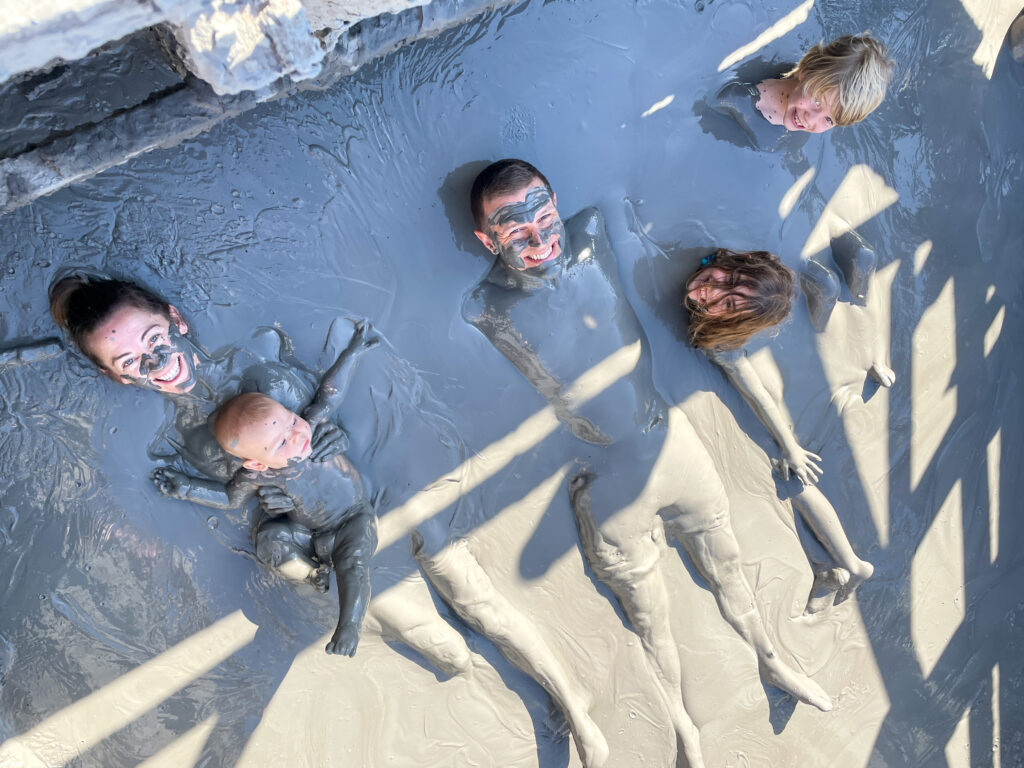
Day 17 – Transfer to Tayrona Park Area (long drive)
The drive from Cartagena to Tayrona Park area is about 5 hours. It’s a long drive, but fairly easy highway driving, as the road doesn’t become curvy until you reach the Tayrona Park area.
Tayrona Park is well worth the drive. The landscape is beautiful on the coastline, with picturesque mountains as the backdrop.
Optional Pit Stops
✔️Along the way, you can stop in Santa Marta for lunch and to walk around the promenade to stretch your legs.
✔️You might opt to visit the house where Simon Bolivar died in December 1830, called Quinta the San Pedro Alejandrino.
Note: Quinta the San Pedro Alejandrino is one of the most important historic sites in Santa Marta, as Bolivar was the commander-in-chief of the patriot army that liberated present-day Colombia, Venezuela, Ecuador, Peru, Bolivia and Panama from Spanish rule. We found the grounds and Quinta a bit underwhelming, but it is a nice spot to stretch your legs if you need it!
Where to Stay in Tayrona Park Area
Cayena Beach Villa was one of our favorite stays in Colombia, quite possibly our favorite. It was a small boutique with an upscale feel and design. There are only ten villas, so it felt private and tranquil.
The property itself is set on the coast, but the villas are set back surrounded by lush jungle plants (sometimes howler monkeys too) and overlooking the beautiful pool. Opt for the option to include breakfast and dinner, as the food was delicious! Next door, there is a restaurant that is delicious for lunch.
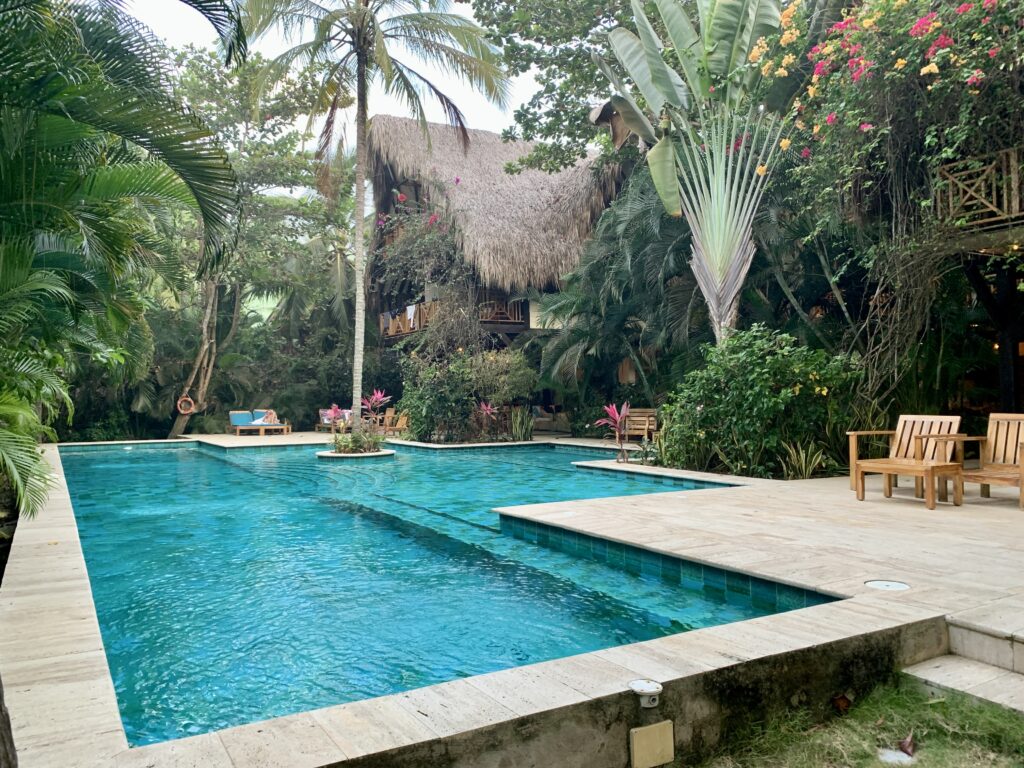
We had two villas, located on the same floor, with huge balconies, high-quality king size beds, gorgeous bathrooms, black-out curtains, and air conditioning. We stayed for a week and could have stayed longer!
Note: The coast can be very rough waters and not always great for swimming. During our stay, the ocean was too rough to go swimming, but the beach was great for walking.
Day 18 – Day trip to Parque Nacional Natural Tayrona (Tayrona Park); Go hiking and swimming
Exploring inside Tayrona Park is a must! From Cayena Beach Villa, it is about a 15-minute drive to the main entrance of Tayrona park, El Zaino entrance. Once you get your ticket, you drive about 10 minutes further to the Cañaveral sector.
While walking is possible, it isn’t really part of the hike and I would suggest driving or taking the shuttle (after you enter El Zaino entrance) to the start of the hike at Cañaveral.
What to Do in Tayrona Park
Hiking and swimming in Tayrona Park make for a perfect active yet relaxing day. The hike from Cañaveral to the beaches of Arenillas and La Piscina is referred to as La Ruta del Conocimiento. This hike takes about 1.5 hrs each way.
You will hike for about 1 hour across the forest until reaching the Arrecifes sector, where you will get great panoramic views of the park. Then, you walk for approximately 30 minutes more to reach the beaches known as Arenillas and La Piscina.
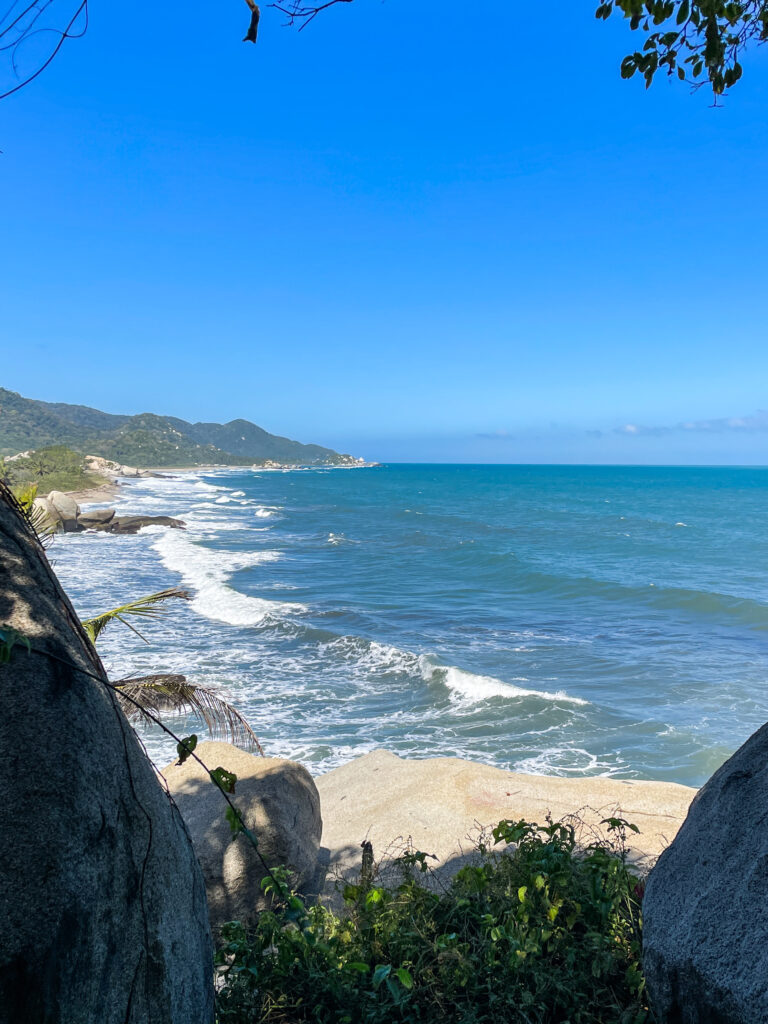
Here, you will find a couple of restaurants, where you can grab a bite to eat and then enjoy swimming at the beaches. When we were there, the beach off to the right was the calmest, so it’s worth walking down for a few minutes to the calm waters.
During the hike there were a couple vendors set up (with popsicles and such). But our favorite was coming across one of the indigenous girls who were cutting fresh coconuts. Nothing beats delicious fresh-cut coconut water straight from the jungle!
Book a Hiking & Swimming Tayrona Park Tour
Day 19 – Parque Nacional Natural Tayrona: At Leisure
We really enjoyed our leisure days at Cayena Beach Villas. A leisurely breakfast, followed by a walk along the beach and then back to the pool for a swim.
However, if you want an activity for today, check out Nueva Venecia (Pueblos Palafitos). More on this below.
Optional Excursion: What to Do in Tayrona Park region
Nueva Venecia (New Venice) is a fishing village located in the middle of the water, with houses, schools, and restaurants all built on stilts. These Pueblos Palafitos are located in La Ciénaga Grande de Santa Marta, the largest coastal lagoon in Colombia. It is a UNESCO World Heritage Site.
From Tayrona park, the drive is about 90 minutes. You arrive at Tasajera and then take a boat ride for another 90 minutes out into the sea before arriving at these colorful wooden houses that make up the village.
The main form of transportation for all the villagers is by canoe. You will see small children going from place to place via canoe, as they navigate through the waterway “streets” from their house to school. You can visit a school, stop for lunch at a restaurant and see the interesting way of life of the villagers.
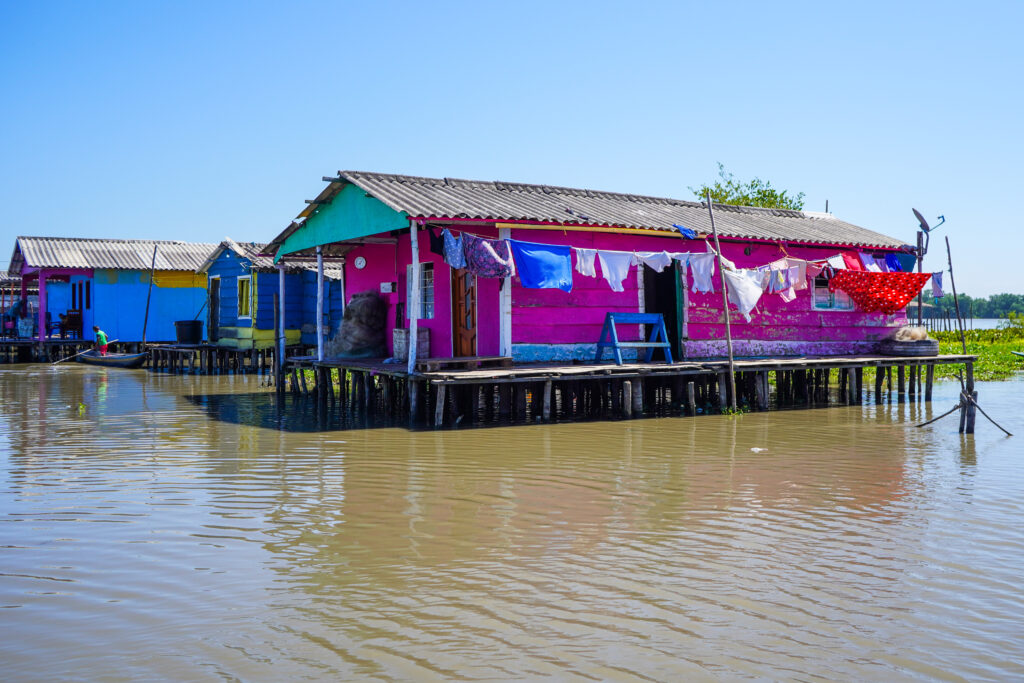
Day 20 – Tayrona Park: Tubing the Don Diego River from Taironaka
Tubing is located in Taironaka, which is a natural reserve located at the foothill of the Sierra Nevada, giving you a different feel for the landscape in the area.
What to Do in Tayrona Park
This adventure is nice because again, you get a little hike, followed by a relaxing tubing float down a natural lazy river. You will also get a little bit of culture, as Taironaka is home to a native Kogui community.
You can take a short hike to see some remains of the terraces and aqueduct structures built by the Tayrona people during pre-Columbian times. There is a little museum and restaurant to grab a snack before heading down to the river.
Here at the Don Diego River, you will get small tubes to use to float down the river. (You need to arrange the tubes ahead of time when starting from this area.) The water can be chilly (it comes from the glacier of the Sierra Nevada), but is ultimately refreshing on a hot day. We all floated together (connected by our feet) for 90 minutes down the natural lazy river.
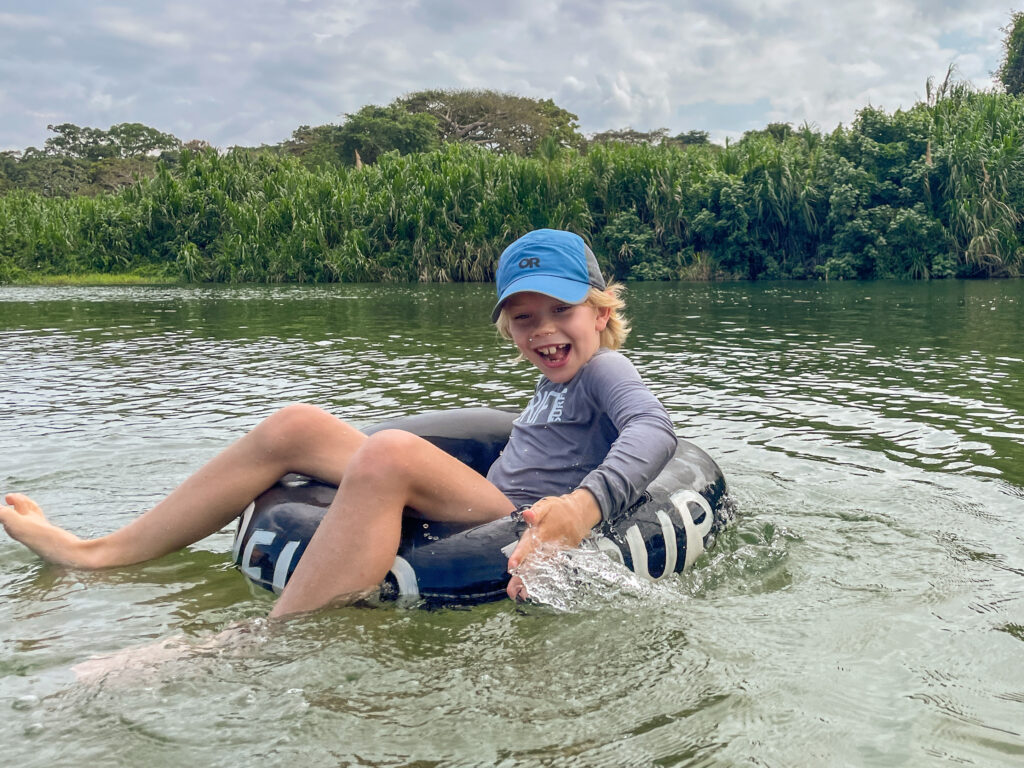
Along the river, there are chances to jump off and swim, as the waters are really shallow and clear. (Depending on rain and time of year, the river can be higher or lower.)
The river ends at the Caribbean Sea, where you can walk along the beach or just swim at the base of the river! Our baby went on this adventure too and just slept most of the ride, enjoying the true relaxation of tubing down the Don Diego River.
Day 21 – Fly out of Santa Marta back to Bogota to catch your international flight home
Your incredible three weeks in Colombia is sadly coming to a close and it’s time to travel back home.
⭐Note: In the Extensions to Spend 6 Weeks in Colombia section below, there are some optional add-ons, should you have more time in Colombia!
Extensions to Spend 6 Weeks in Colombia
Should you have more time in Colombia, we suggest taking extra days in each area to really enjoy each region and have more leisurely time. Here are some ideas for extending your Colombia itinerary:
✔️ From Santa Marta, fly to Bucaramanga. From there you can drive to Barichara (note, the roads are very curvy). Along the route, you can stop at Parque Chicamocha to take the world’s longest cable car ride.
✔️ Spend some days in Barichara. This is where we decide to go glamping at Nativo Glamping, located about a 10-minute tuk-tuk ride outside of the cute picturesque town of Barichara.
The glamping here was so fun and peaceful and the owners were really nice and helpful. The chef made up any type of food we wanted, from smoothie bowls to guacamole, and even held a cooking class for the kids. It was like having a personal chef for us for a week!
Barichara is a less popular tourist destination because it is harder to get to, but it has all the small-town charm and unique style of architecture.
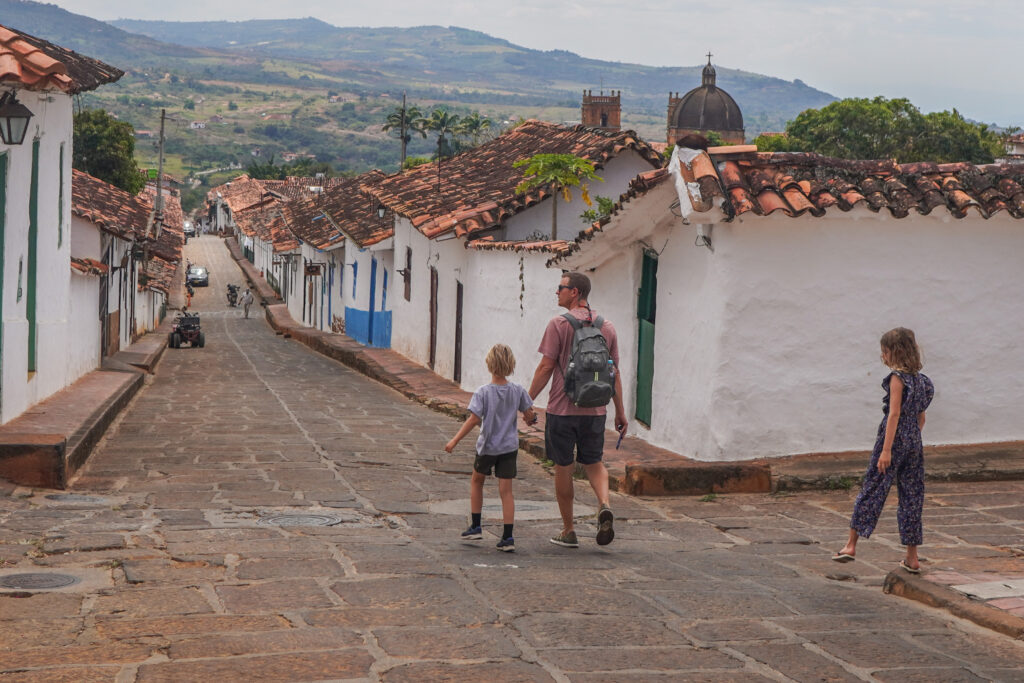
✔️ From Barichara, drive to Villa de Leyva (the drive is less windy, but still has lots of curves). Villa de Leyva is a popular town in Colombia, as you can also access it within a few hours of Bogota. It’s a picturesque town with lots of shops and restaurants.
✔️ From Villa de Leyva, you can drive to Bogota and even consider stopping in Zipaquira along the way to visit the Salt Cathedral on your route back to Bogota.
✔️ Depending on the time of year, consider visiting the Pacific Coast to see the whales.
✔️ If you are up for an adventurous hike, check out La Cuidad Perdida, The The Lost City Hike in the Tayrona Park area. This hike can take 3-6 days and is designed to be accessible but not easy by any means. The camps along the way are basic, so prepare accordingly.
✔️ Look into the Bamboo Rafting Quimbaya Tour. We were told we couldn’t take a baby, so we took this off our itinerary, but it was definitely something that looked fun.
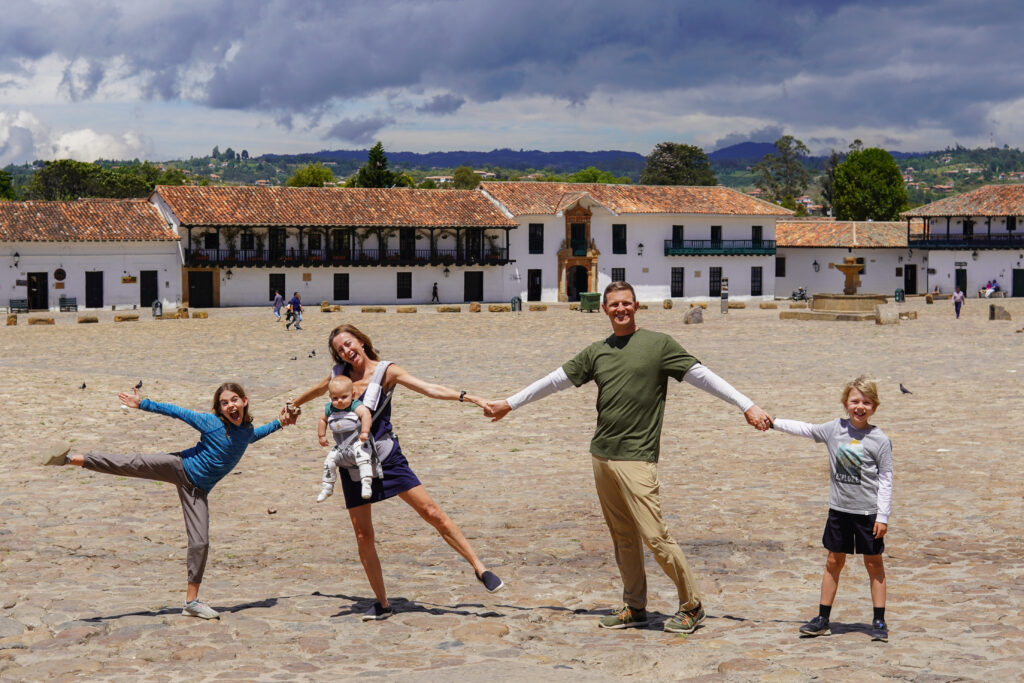
Top Areas of Colombia to Visit
Colombia is a country filled with diverse landscapes and regions. It has a coastline on the Caribbean Sea and the Pacific Ocean, vast mountainous regions, and of course the tropical Amazon Rainforest.
For an easy go-to reference, here is a rundown of the various areas of Colombia that you should consider :
Bogota
Bogota is the capital located in the central part of Colombia. This Andean region has a really high altitude and year-round cooler and rainy weather. Bogota is famous for going through all “four seasons” in 24 hours, which is helpful to know before venturing out each day.
Be prepared for all the weather – cold, warm, and rainy – all on the same day. Bogota is also quite inexpensive and we found it easy to walk around. You can travel from Bogota to many great attractions including the famous Salt Cathedral.
Pereira
Pereira is also known as the Coffee Region. The Pereira airport is where you’ll fly to in order to explore towns like Salento (think of the movie Encanto), as well as beautiful hikes in Cócora Valley.
Temperatures are usually warm in the Coffee Region, but the Cócora Valley can be a bit cooler. When we hiked through Cocora Valley, we were sweating in the hot sun one minute, then we were chilly, and then it poured rain!
Medellin
Medellin is the city of eternal spring. This is the airport you’ll fly into to explore the Guatapé region and Penal Rock. Medellin is also famous for guitar making and the Comuna 13 neighborhood. Most people love Medellin. To be honest, we found the city was just okay.
Cartagena
Cartagena is the most touristic of Colombia’s cities. It is located on the northern coast and is known for being hot and humid. Here you will find beautiful Caribbean beaches and some great islands to explore.
Santa Marta
Santa Marta is located about a 5-hour drive from Cartagena. It’s a small city and has an airport which you could fly into to access the Tayrona Park area more easily (although there weren’t any direct flights from Cartagena when we looked).
Tayrona Park is incredible and worth going to! This is also the area where you can start the hike to The Lost City (Cuidad Perdida).
Bucaramanga
Bucaramanga is a gateway city to explore the picturesque towns of Barichara and Villa de Leyva. From Bucaramanga airport to Barichara the roads are very curvy.
You can also access Villa de Leyva from Bogota. (This area is more difficult to travel to, which is why we left it off the three weeks in Colombia itinerary. However, it is a great add-on, if you have time.)
Cali
Cali is a city in the southwest of Colombia known for dancing. In particular, it is known as the salsa capital. We didn’t make it here during our time in Colombia.
Bahía Malaga
Bahía Malaga is the Pacific coastal area known for whale migration during the months (July through October). While we really wanted to see these magical creatures, the timing didn’t work for us (and just gives us another reason to return to Colombia for another trip).
Los Llanos
Los Llanos are Colombia’s Eastern Plains, which can be hot and dry. You’ll find destinations such as Villavicencio, Yopal, San Jose del Guaviare and Caño Cristales. We originally had this on our trip itinerary, but removed it because we packed in a little bit much already!
Top Experiences in Colombia You Don’t Want to Miss
While we have given you the details of a day-by-day itinerary for three weeks in Colombia, here is a quick reference list of our favorite unique experiences in Colombia that you should absolutely check out when planning your trip.
Details of each tour are in the detailed 3 Week Colombia Itinerary above.
1. Jungle Jeep Tour + Organic Cacao Farm
Location of Tour: Coffee Region
Airport: Pereira
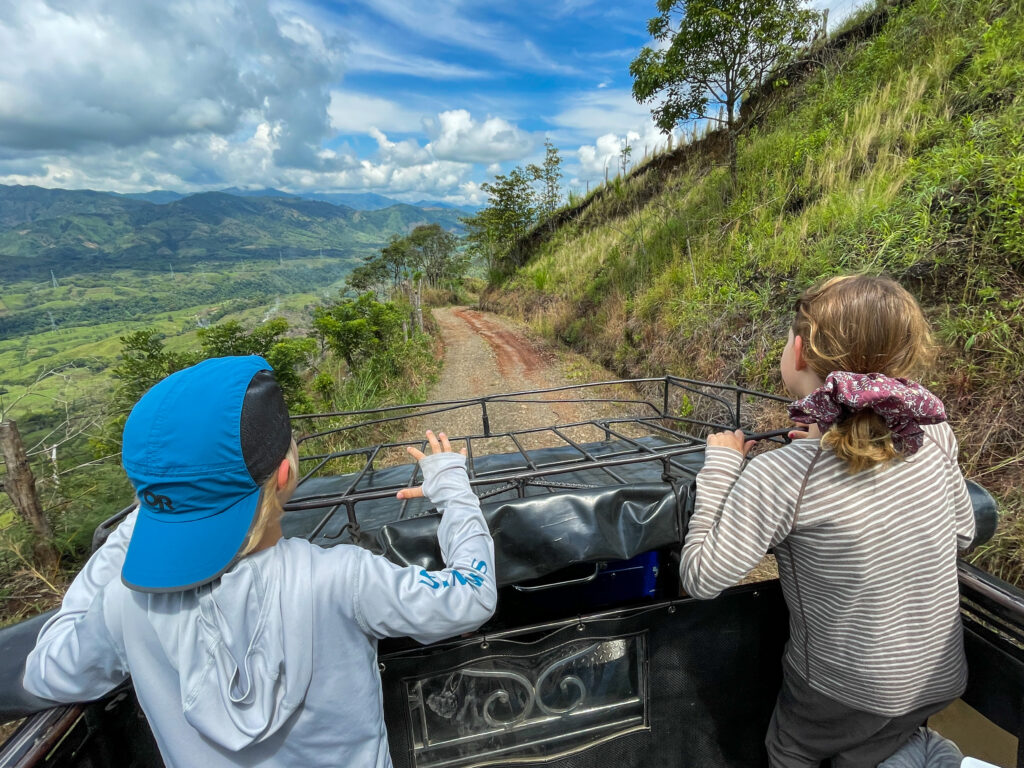
Contact Brisas del Cauca directly to book – it’s worth it!
2. El Barrio Egipto Tour in Bogota
Location: Neighborhood above La Candelaria
Airport: Bogota
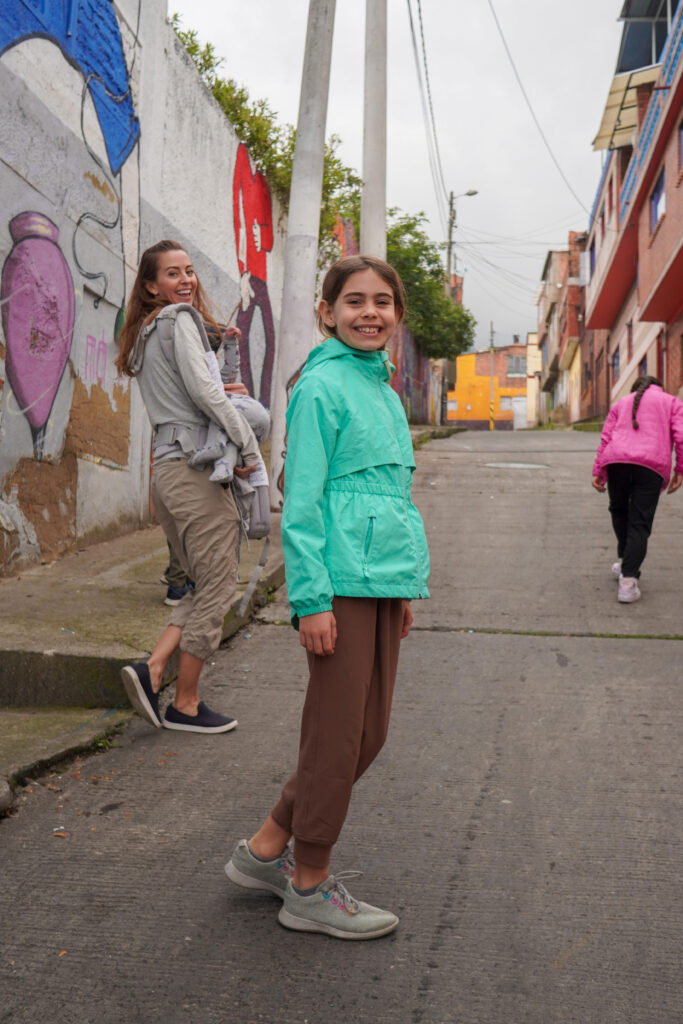
3. Hiking in Cócora Valley
Location of Tour: Coffee Region
Airport: Pereira
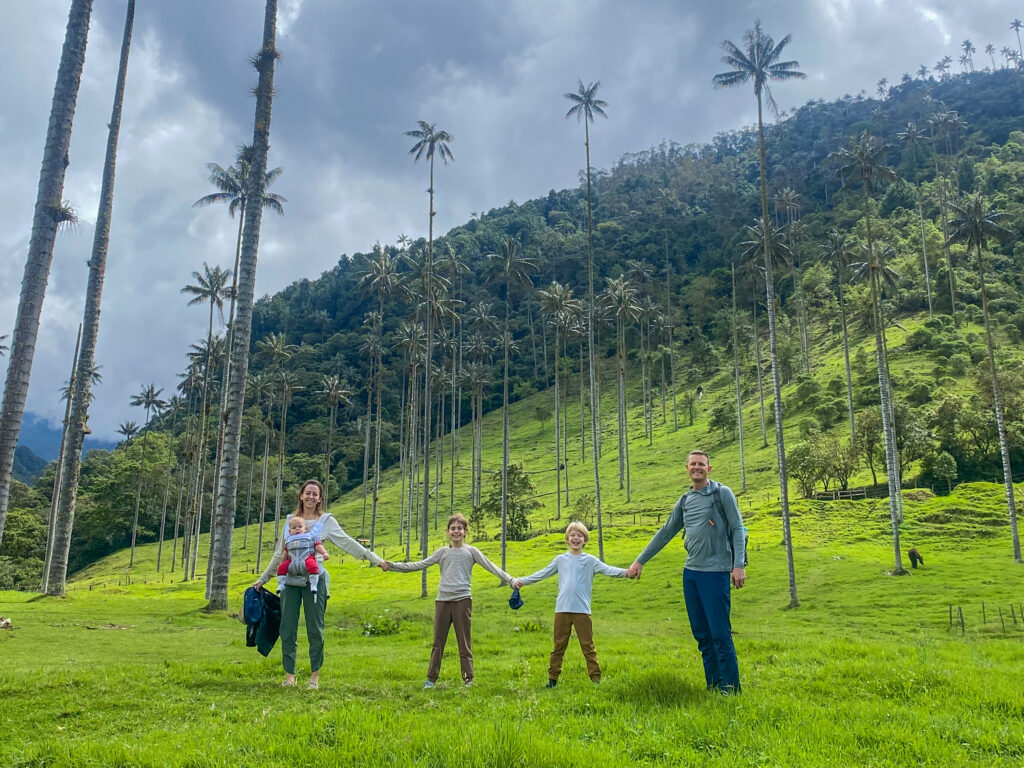
4. Cooking Class
Location of Tour: Bogota
Airport: Bogota
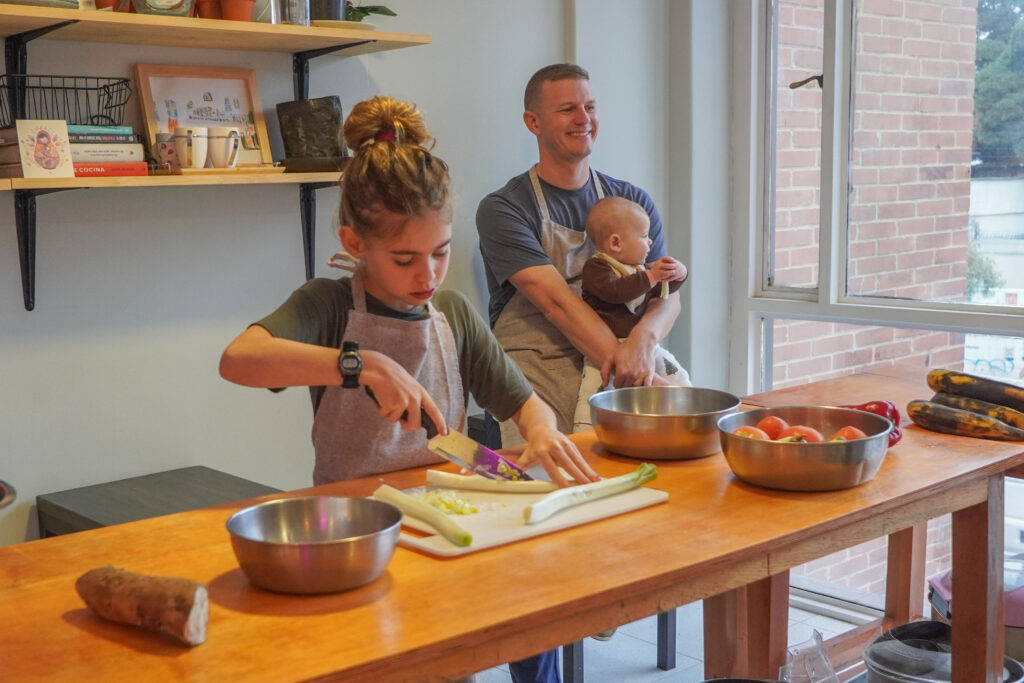
5. El Totumo Mud Volcano
Location of Tour: 45 mins outside of Cartagena
Airport: Cartagena
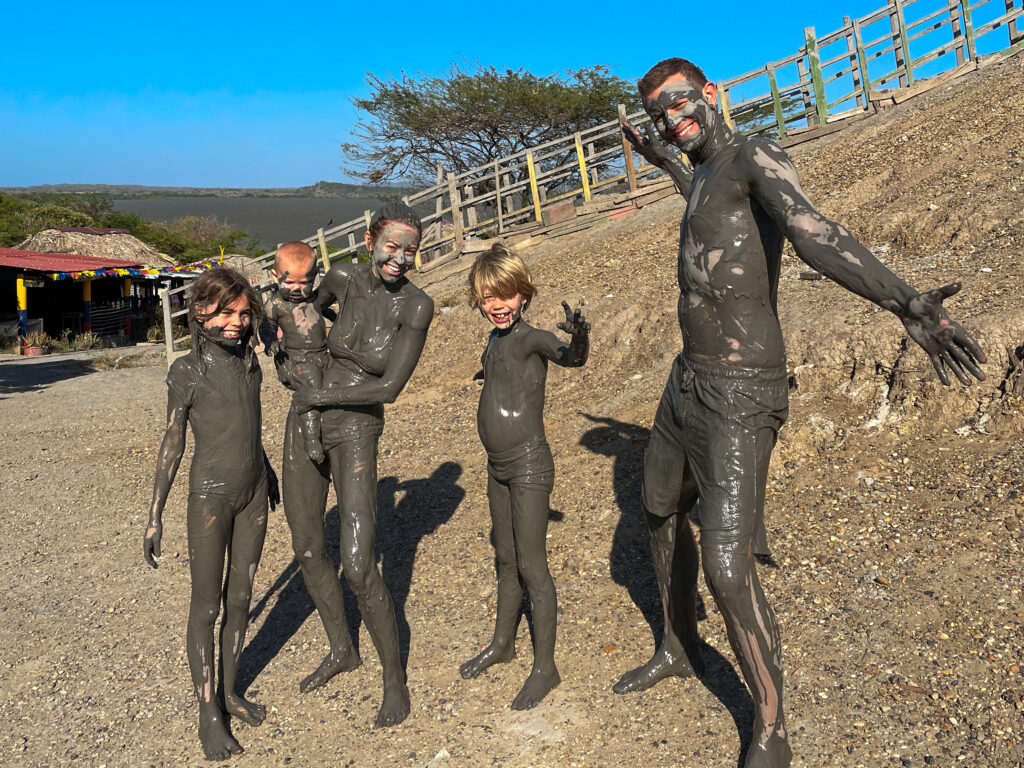
Book a Tour to El Totumo Mud Volcano
6. Salt Cathedral
Location of Tour: Zipaquira (1 hour outside of Bogota)
Airport: Bogota

View Zipaquira Salt Cathedral Tours
7. Tubing down the Don Diego River
Location of Tour: Tayrona Park Area
Airport: Santa Marta
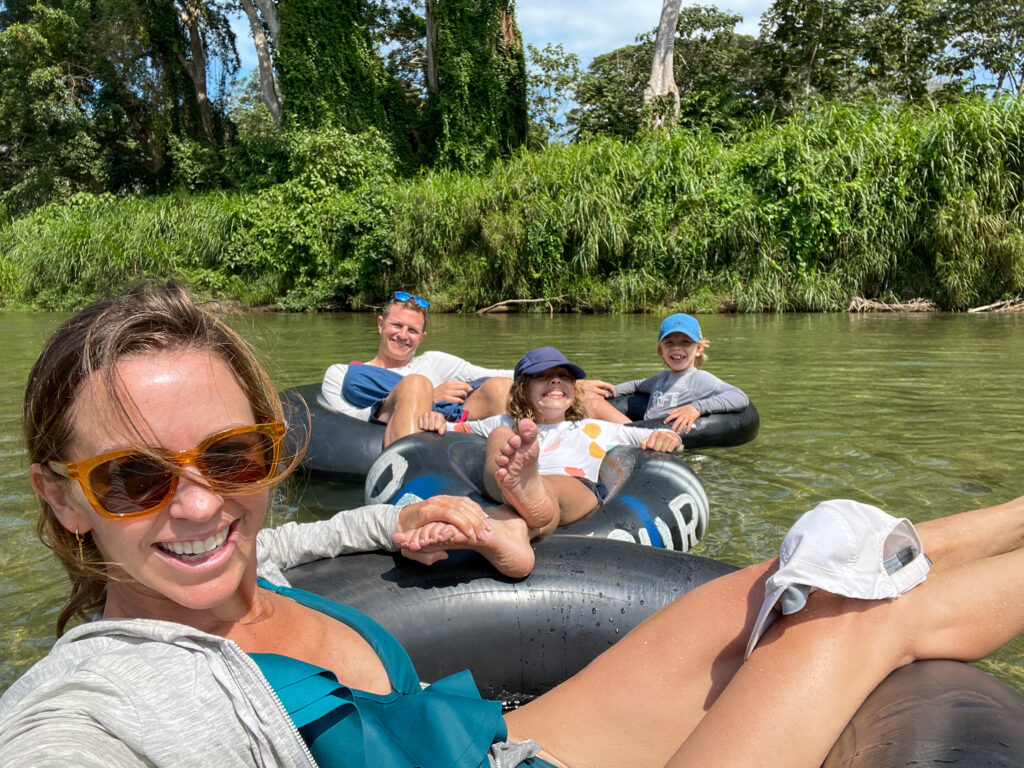
Is 3 Weeks in Colombia Enough?
Colombia is a diverse country with many different regions and an abundance of things to do. Of course, it would be challenging to cover the whole country within three weeks in Colombia. However, it is absolutely possible to have a fulfilling trip by prioritizing which types of activities are important to you.
Most people we met who were touring through Colombia, were doing so in about 2 weeks, hitting the Coffee Region, Medellin, Cartagena and sometimes even Tayrona Park in that timeframe. Your Colombia itinerary can cover as much or as little as you want.
If you have more time, as we did when we spent 6 weeks in Colombia (we worldschool our kids so we don’t have to follow a school calendar), you could have time to see other areas such as Barichara and Villa de Leyva, or even do the Lost City Hike.
To be honest, I really wanted to do the Lost City Hike but with a 6-month-old, we figured we would come back in a couple of years to make it a bit easier! Depending on the time of year you are in Colombia, I would suggest looking into the whale migration on the Pacific Coast as well.
Get specific about what is important to you and what you want to walk away with at the end of your trip to Colombia.
Do you want to walk away having seen as much as possible? Have specific experiences? Relaxing and reviving? Learning and cultural exploration? Do you want to move quickly and sacrifice going in depth in a region? Or do you want to linger and spend more time in one place?
Taking into account your travel style, your interests and the time you have available will determine if 3 weeks in Colombia is enough time.
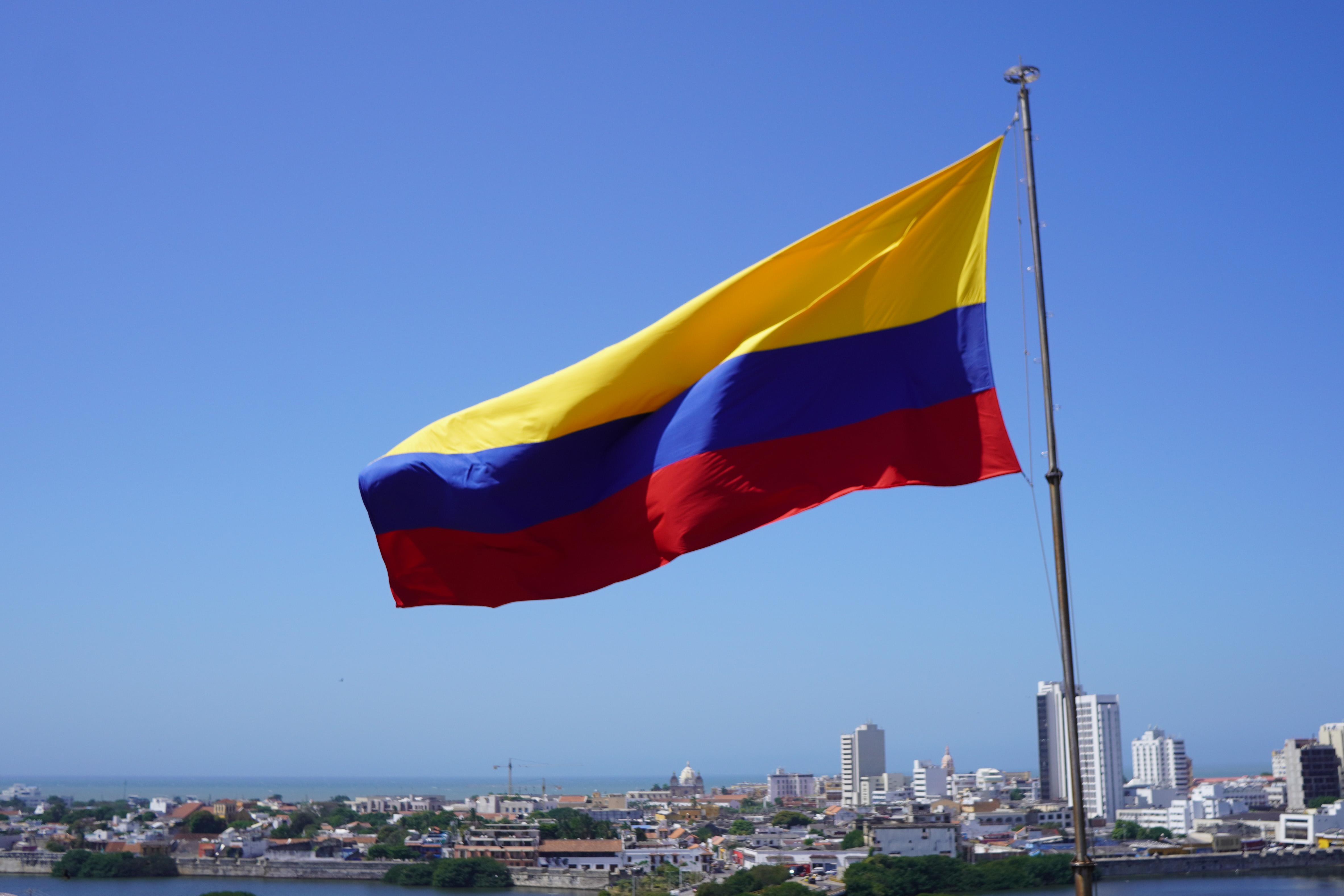
Is Colombia Safe for Travel?
This is the question we get asked most often.
Colombia has come a long way in terms of safety over the past few years. In short, we found it to feel very safe. However, I hesitate to say anything is safe as the term is relative and things can happen anywhere.
For us, we felt safer in Colombia than in many parts of our home country (USA). But, like any country you travel to, it is important to exercise caution and be aware of your surroundings while traveling in Colombia.
While many parts of Colombia are safe to visit, there are still some areas that are considered high-risk due to drug trafficking, political unrest, and other criminal activities. (Again, like many places in the world.) Make sure to check the latest safety information before you travel.
There are definitely some precautions that you can take, such as avoiding traveling alone at night, especially in isolated or unfamiliar areas, and using caution when taking public transportation. It is also important to keep a close eye on your belongings and be aware of pickpocketing and theft in crowded areas.
That being said, Colombia has become an increasingly popular travel destination in recent years, with its beautiful landscapes, rich culture, and friendly people. If you take the necessary precautions and do your research beforehand, you can have a safe and enjoyable trip to Colombia. We absolutely loved our trip to Colombia!
Tip: It is always a good idea to consult with a travel advisor or the embassy of your home country for the latest safety information before your trip.
Travel Insurance for a Trip to Colombia
We highly recommend that you purchase travel insurance for a trip to Colombia. We always purchase travel insurance to provide coverage for unexpected situations that may arise and it has proven beneficial.
Consider what extent of coverage you want when looking at travel insurance. Do you want coverage for things like medical emergencies, trip cancellation or interruption, lost or stolen luggage, or adventure activities (should you wish to partake in things like whitewater rafting, or zip lining)? Not all travel insurance policies cover these things.
Before purchasing a travel insurance policy, carefully read the policy documents and understand what is covered and what is not covered to best suit your needs.
We have used both Safety Wing and World Nomads, and have made claims with both. For the past couple of years, we switched from World Nomads to Safety Wing, simply because Safety Wing is much less expensive. However, we would recommend either of them.
Domestic Flights in Colombia
We took four domestic flights within Colombia. To be honest, we had low expectations for these domestic flights. Yet, to our surprise, each airline was actually quite nice. We traveled on Avianca, as well as Latam domestically throughout Colombia.
Here were the airlines and flights we took within Colombia:
Bogota to Pereira: Avianca
Pereira to Medellin: Latam
Medellin to Cartagena: Latam
Santa Marta to Bucaramanga: Avianca
Additionally, after looking into many options for an international flight from the United States to Colombia, we decided to book Jet Blue roundtrip from Fort Lauderdale. Jet Blue has very comfortable seats and was an easy international flight.
Language in Colombia
Spanish is the official language in Colombia. To be honest, we found that English was not as widely spoken as we had anticipated. This gave us a great chance to practice our Spanish.
However, if you don’t speak any Spanish, you may want to consider having a guide with you for some parts of your tour throughout Colombia.
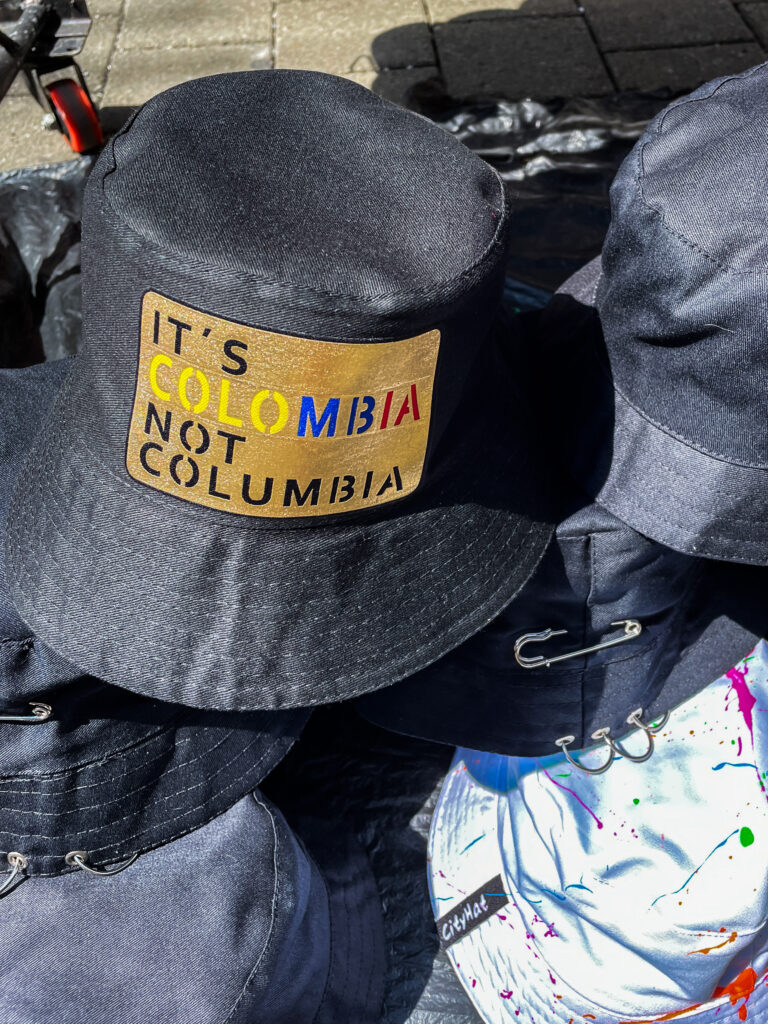
Expected Budget for 3 Weeks in Colombia
You can absolutely do Colombia on a budget. Honestly, it’s one of the best countries we’ve visited recently in terms of value!
(Speaking of budget, vacationing in Syros Greece also makes the list for a great budget-friendly destination. Self-driving in Jordan was a reasonable cost. And, the Tuscany region of Italy was one of the more expensive destinations we visited this year.)
Tourism is just picking up in Colombia in recent years and things are still cheap (accommodations, food, tours, flights, etc.). There really isn’t a better time to travel to Colombia, in our opinion!
Of course, the expected budget for a 3-week trip to Colombia largely depends on the type of accommodation, transportation, and activities you choose.
For example, we spent around USD$25 for four people to eat high-quality vegetarian meal consisting of freshly squeezed juices of our choice, amazing smoothie bowls and a couple of entrees. This will vary a bit in each region, but overall food costs are low and the quality and freshness is high.
If you are planning and booking everything yourself, on average, you can expect to spend between $1,500 to $2,500 USD per person (for kids expect to pay less). This would include mid-range accommodation, taking local transportation, food and drinks, and some activities.
We took a 6-week tour for our family of five (two adults, two children and a baby) throughout many regions in Colombia, packed with activities and mid to upper-range accommodations. Most hotels included breakfast, and some days included lunch or dinner.
Including all our domestic flights, accommodations, activities, some meals, tour guides and drivers, our Colombia tour cost approximately $20,000 USD for six weeks. (Not including international flights, tips, other meals and travel insurance.) Of course, you can do Colombia much cheaper by planning it yourself.
Currency in Colombia
The currency used in Colombia is the Colombian peso (COP), which is abbreviated as “$” with the symbol “COL$”. Do your research before traveling to Colombia, but at this time the approximate conversion is USD$1 = COL$4800.
Colombia Budget Travel Tips
If you are budget conscious, consider the following tips:
✔️Travel during the low season (from April to June or September to November). During this time, accommodation and transportation costs can be lower, and there are usually fewer crowds.
✔️Traveling to fewer regions will also make your trip more cost-effective.
✔️Research free or low-cost activities and attractions, such as free walking tours or visits to local markets to minimize your costs.
Tour Guide vs Self-Guided Tours in Colombia
At times when we travel, we opt to plan through a tour company, while other times, we plan everything ourselves. While hiring a tour company seems like an easy option, for us, it takes a lot of research to find the perfect tour company that we feel understands the type of travel that we want to experience.
Tips for finding a tour company in Colombia
We look for a tour company that takes into consideration responsible tourism, can get us a little off-the-beaten-path into the local culture, and can find us unique experiences that we otherwise wouldn’t find.

While we opted to use a tour company to plan our trip to Colombia, you can absolutely do a self-guided tour of Colombia and plan it yourself. That is really why I took the time (a lot of time!) to write out a three-week itinerary for Colombia full of information. As our community saw the photos and activities we were doing in Colombia, I had nonstop requests to share our favorite experiences and itinerary.
Of course, whether to hire a tour guide or go self-guided during your travels in Colombia largely depends on your preferences, budget, and travel style. You could opt to plan most of the details yourself and hire a tour guide or driver for the days you need them.
The benefit of hiring a tour guide is that they can provide valuable insight into the destination and we tend to feel more connected to a place when we really understand and learn about it.
Tip: I should note that when hiring a tour company, we are also very particular about what we like and don’t like. We aren’t afraid to share our preferences with the tour company, and we suggest you do the same.
For example, we like the fun facts and not all the long drawn-out details. We can skip most museums and churches, as we’ve seen a lot on our travels. In addition, we make it clear that we need leisurely time and fun activities that involve the kids.
Hiring a tour guide can also help ensure a level of comfort and safety, having extensive knowledge of the area and up-to-date safety insight.
Additionally, for some attractions in Colombia, such as trekking to the Lost City or visiting indigenous communities, being accompanied by a licensed tour guide may require a guide by law.
Self Guided for your Colombia itinerary
On the other hand, going self-guided allows for more flexibility and independence, and can be more cost-effective. You have the freedom to explore at your own pace and connect with locals.
Ultimately, the decision between a tour guide and self-guided travel in Colombia depends on your personal preferences and travel style for this particular trip in Colombia.
Finding the Right Tour Company
I typically narrow down a list to about a dozen tour companies and then interview about half of that list before I decide on a company that I feel is worth the extra money. (And believe me, some of our best trips have taken are because we used amazing tour companies.)
We then did a lot of research to determine which types of experiences we want to have in Colombia. There are many drafts back and forth with itineraries to get it right. It absolutely takes time, but also saves us a lot of time not having to book all the details.
We also don’t have to think much about our plan during our trip and instead can just enjoy that everything is taken care of. Lastly, we asked that all our tour guides speak Spanish so that our kids could practice their Spanish language skills. Of course, you can opt to have your tour guide speak your language.
On a side note, if you are looking for really easy travel with kids, check out Boundless Life worldschool destinations, as they take care of accommodations, activities, school, co-working space and you’ll have a built in community of other families for socialization!
Best Time to Go to Colombia
Colombia has two seasons, the dry season (December-March, and July-August) and the rainy season (April-June and September-November).
Remember, Colombia is located very close to the equator, so it has a tropical climate. However, depending on the region, it isn’t always as hot as you think it may be.
Bogota, for example, has a very high altitude and cool temperatures in the 60s for much of the year, with consistent rainy days. Whereas Cartagena can be quite hot and humid year-round. Medellin is known as the city of eternal spring, with temperatures hanging in the 70s most of the year.
Of course, there are pros and cons to both seasons, but ultimately, the best time to visit Colombia depends on the regions you plan to visit and the activities you want to do.
The dry season is generally considered the best time to visit Colombia, especially during the months from December to March. Sightseeing and outdoor activities are easier during this time, as the weather is generally warm and sunny with lower humidity in most parts of the country.
Just keep in mind that some areas are cooler and wetter (even in the dry season) than you may anticipate. Bogota gave us a bit of a surprise, as we tried to contend with the rain and the cooler days. Yet, it was also really nice to walk around and not be sweating!
The rainy season, on the other hand, can be quite wet and humid, particularly in the Amazon and Pacific regions. However, this can also be a good time to visit if you’re interested in birdwatching, whitewater rafting, or seeing the lush green landscapes.
Overall, the best time to visit Colombia depends on your preferences and the activities you plan to do. If you want to avoid the crowds and high prices, it may be best to travel during the shoulder seasons (April-June or September-November) when the weather is still good but there are fewer tourists. And remember, that just because it’s the dry season, doesn’t mean that it won’t rain!
What to Pack for a Trip to Colombia
When packing for a trip to Colombia, it is important to consider the climate and the activities you plan to do. We like to travel as lightly as possible (not always easy with a baby) when hopping around a country.
For our family of five, we managed to pack everything we needed within four carry-on suitcases (two of them were backpacks) plus a couple of extra bags, and of course, our Doona Stroller/Carseat (worth every cent)!
Tip: Remember to check the baggage allowance with your airline before packing, as different airlines have different restrictions.
Here are some essential items for your Colombia packing list:
✔️Lightweight clothing that you can layer: As Colombia has a tropical climate, lightweight and breathable clothing is essential. But you’ll want layer options, especially if visiting Bogota or cooler regions.
We tend to like technical quick dry clothing (as often, we need to do laundry in the shower between finding actual places to do our laundry). Columbia and Patagonia tend to be our go-to brands, while we can find some kids’ quick dry items at Old Navy and Target.
✔️Shoes: We each packed one pair of flip flops (I packed my Ola Kaui flip flops), one pair of lightweight sneakers/water shoes (I like Sperry’s version) plus one everyday shoe that we can walk around in or use to dress up a little (I love these Allbirds, which are especially useful for city walks).
✔️Rain gear: We visited Colombia during the dry season and still could have used an umbrella and lightweight rain jackets! However, ponchos pack really nicely and are great options to bring for the dry season. If traveling during the rainy season, I would suggest a true rain jacket for sure.
✔️Sun protection: As Colombia is located near the equator, the sun can be intense. Pack sunscreen, a hat, and sunglasses to protect your skin and eyes. Hats with large brims and neck coverings like these kids or these for baby are very helpful.
For sunscreen, we are very particular about non-toxic products and use all Beautycounter – it’s reef friendly and safer for our skin, plus gives amazing protection without making us white as ghosts.
⭐Tip: I am a consultant with Beautycounter (an income stream that helps support our travels!), so you can purchase sunscreen or reach out with any questions.
✔️Insect repellent: The areas in Colombia where we really thought we’d need repellent, we barely got a bite. And then other areas where we didn’t think there would be mosquitos (such as Villa de Lleyva), we got eaten alive (though we didn’t have on long pants or bug spray). Lightweight long sleeves and pants help a lot, but make sure you pack bug spray. We like these insect-repellent wipes for travel.
Tip: Our favorite bug control tool is this simple suction tool called The Bug Thing that helps negate the itchy effect when you do get a bug bite!
✔️Money belt: There are lots of money belt variants out there, but this money belt is by far our favorite and the most discrete!
✔️Adaptor: Bring an adaptor for electrical outlets as they may differ from what you are used to.
✔️First Aid Kit: Pack any necessary medications, as well as a basic first aid kit.
✔️Camera: Colombia has stunning landscapes and colorful cities. We mainly used the Sony Alpha A6600 Mirrorless Camera and this Lens to capture our memories (which takes high-quality photos and isn’t bulky – it’s a super reasonable size for traveling).
✔️Backpack or daypack: A comfortable backpack or daypack is useful for carrying water, snacks, and other essentials while exploring. We like this easy waterproof backpack for day outings (get a waterproof one because you will otherwise sweat through it!) and this Osprey Daypack for travel days to have the option of carrying it on our shoulder, as luggage or backpack-style.
✔️Water Bottle: You will be drinking bottled water a lot. Because bottled water comes in all different qualities, we prefer to use these Clearly Filtered water bottles to filter our water. We have them in both the small and large sizes and prefer the larger one because it holds more water.
✔️Luggage: We have tried so many different types of luggage. We keep returning to Eagle Creek brand. We love this Eagle Creek International Carry On Luggage 30L Duffle with backpack straps.
✔️Baby Carrier: If you are traveling with a baby, a baby carrier is a must. I used this Ergo Baby almost everyday (even when hiking for hours), but we also carried this Boba Air Ultra Lightweight Carrier at times when we weren’t sure if we really needed a carrier or we didn’t want to pack the Ergo Baby.
The benefit of the Boba Air is that it packs up really small, but the downside is that it doesn’t have much support and doesn’t allow baby to face out (but it does turn into a backpack style also as your child grows).
✔️Packing Cubes: We’ve purchased so many different types of packing cubes over the years, but we go back to these compression packing cubes every time!
✔️Portable High Chair: This compact portable high chair is a life saver and super compact, plus it fits on just about any chair. Most places didn’t have a high chair for our baby, or if they did, it was really unsafe.
⭐For more travel product recommendations, check out our Travel Resources page dedicated to all the stuff we travel with!
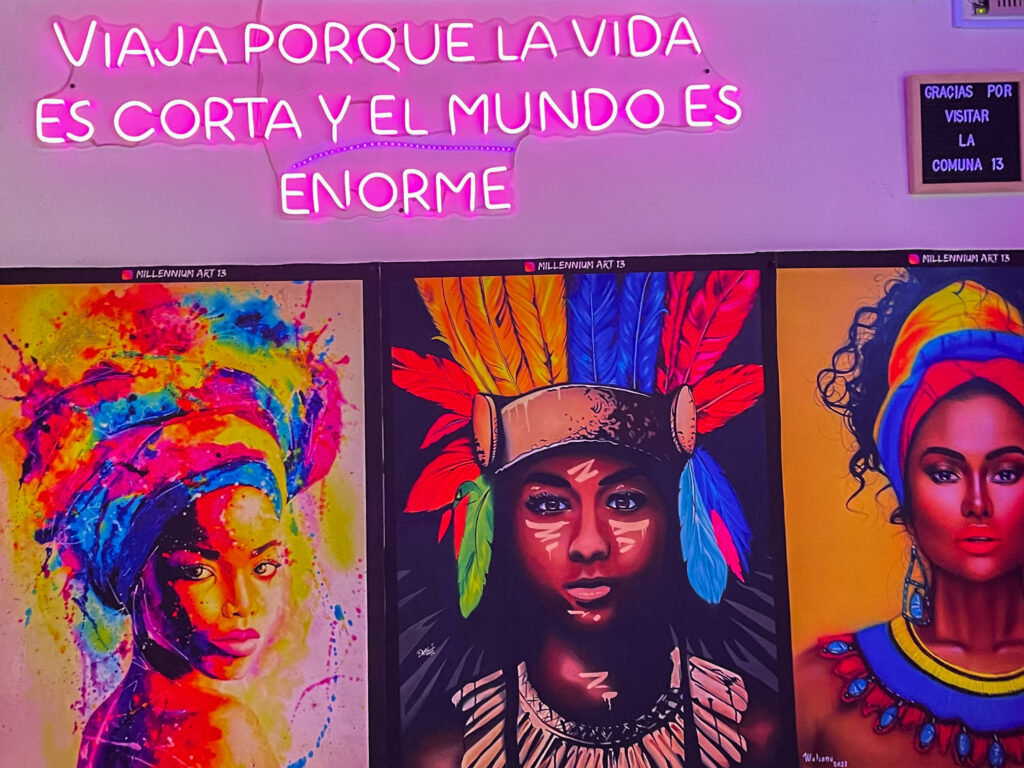
Conclusion: Colombia 3 Week Itinerary
Your Colombia 3-week itinerary can be an incredible travel experience filled with diverse landscapes, rich culture, and fresh delicious food. With a variety of destinations to choose from, you can explore colonial cities, hike in the Andes Mountains, learn to cook typical Colombian cuisine, relax on Caribbean beaches, or discover the country’s coffee and cacao culture.
With proper planning and a spirit of adventure, a 3-week trip to Colombia can be an incredible journey full of unforgettable memories.
Up Next:
Unique Helicopter Tours in Medellin & Guatape
More Passport Explorers Adventures
Boundless Life Review: Worldschool Hubs
Syros Beaches are Some of the Best in Greece
Grand Cayman Family Vacation: Top Activities + Where to Stay
Delicious Fruit in Greece You Should Try
12 Best Family Resorts in Barbados + BONUS Vacation Guide

